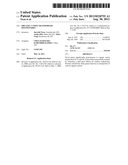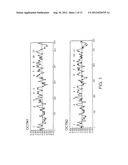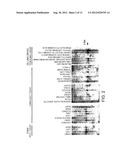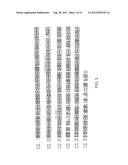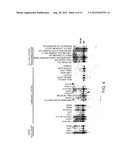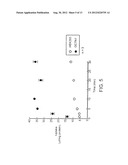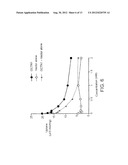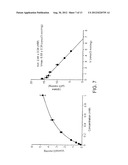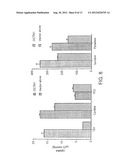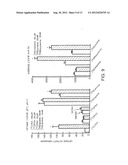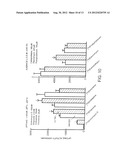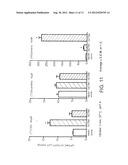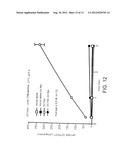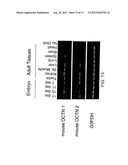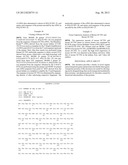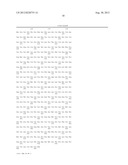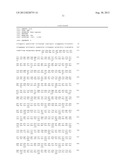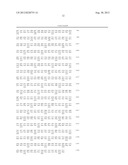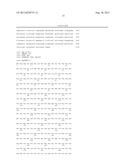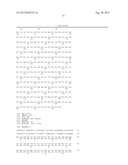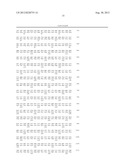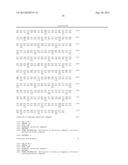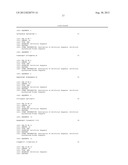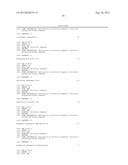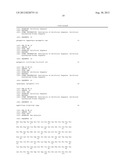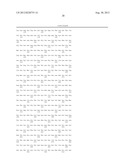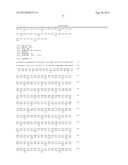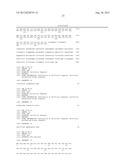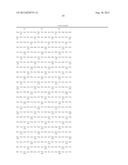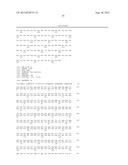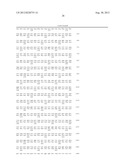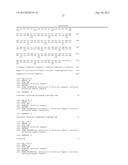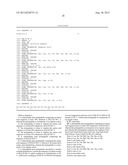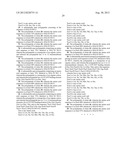Patent application title: ORGANIC CATION TRANSPORTER POLYPEPTIDES
Inventors:
Jun-Ichi Nezu (Gotemba-Shi, JP)
Asuka Oku (Shiroi-Shi, JP)
Akira Tsuji (Kanazawa-Shi, JP)
Assignees:
Chugai Seiyaku Kabushiki Kaisha
IPC8 Class: AC07K14435FI
USPC Class:
530350
Class name: Chemistry: natural resins or derivatives; peptides or proteins; lignins or reaction products thereof proteins, i.e., more than 100 amino acid residues
Publication date: 2012-08-30
Patent application number: 20120220755
Abstract:
Novel genes significantly homologous to organic cation transporters OCT1
and OCT2 have been successfully isolated by screening a fetal gene
library by random sequencing. Proteins encoded by these genes function as
transporters of various organic cations.Claims:
1. A substantially pure polypeptide comprising an amino acid sequence at
least 70% identical to SEQ ID NO.: 3, wherein the polypeptide is a
transporter of an organic cation.
2. The polypeptide of claim 1, wherein the amino acid sequence is at least 80% identical to SEQ ID NO: 3.
3. The polypeptide of claim 1, wherein the amino acid sequence is at least 90% identical to SEQ ID NO: 3.
4. The polypeptide of claim 1, wherein the amino acid sequence is at least 95% identical to SEQ ID NO: 3.
5. A substantially pure polypeptide comprising the sequence of SEQ ID NO: 3.
6. A substantially pure polypeptide comprising the amino acid sequence of SEQ ID NO: 3, with up to 30 conservative amino acid substitutions, wherein the polypeptide is a transporter of an organic cation.
7. A substantially pure polypeptide encoded by a nucleic acid that hybridizes to a probe the sequence of which consists of SEQ ID NO.:4, under conditions of: hybridization at 68.degree. C., followed by washing in 2.times.SSC/0.1% SDS for 20 minutes at room temperature and twice in 0.1.times.SSC/0.1% SDS for 20 minutes at 50.degree. C., wherein the polypeptide is a transporter of an organic cation.
8.-27. (canceled)
28. A substantially pure polypeptide comprising an amino acid sequence that is at least 70% identical to SEQ ID NO:3, wherein the polypeptide is a transporter of an organic cation, and wherein the polypeptide comprises the sequence Xaa1-Xaa2-Xaa3-Xaa4-Xaa5-Xaa6-Xaa7-Gly-Arg-Xaa8-Xaa9-Xaa10-Xaa11-Xaa12 (SEQ ID NO:33), wherein Xaa1 is Leu, Ile, Val, Met, Ser, Thr, Ala, or Gly; Xaa2 is Leu, Ile, Val, Met, Phe, Ser, Ala, or Gly; Xaa3 is any amino acid; Xaa4 is Leu, Ile, Val, Met, Ser, Ala; Xaa5 is Asp or Glu; Xaa6 is any amino acid; Xaa7 is Leu, Ile, Val, Met, Phe, Tyr, Trp, or Ala; Xaa8 is Arg or Lys; Xaa9 is any amino acid; Xaa10 is any amino acid; Xaa11 is any amino acid; and Xaa12 is Gly, Ser, Thr, or Ala.
29. A substantially pure polypeptide consisting of the sequence of SEQ ID NO:3.
30. The polypeptide of claim 28, wherein the amino acid sequence is at least 76% identical to SEQ ID NO:3.
31. The polypeptide of claim 28, wherein the amino acid sequence is at least 80% identical to SEQ ID NO:3.
32. The polypeptide of claim 28, wherein the amino acid sequence is at least 90% identical to SEQ ID NO:3.
33. The polypeptide of claim 28, wherein the amino acid sequence is at least 95% identical to SEQ ID NO:3.
34. A substantially pure polypeptide comprising an amino acid sequence at least 76% identical to SEQ ID NO:3, wherein the polypeptide is a transporter of an organic cation, and wherein the polypeptide has 11 to 12 transmembrane domains.
35. The polypeptide of claim 34, wherein the amino acid sequence is at least 80% identical to SEQ ID NO:3.
36. The polypeptide of claim 34, wherein the amino acid sequence is at least 90% identical to SEQ ID NO:3.
37. The polypeptide of claim 34, wherein the amino acid sequence is at least 95% identical to SEQ ID NO:3.
38. A substantially pure polypeptide comprising an amino acid sequence at least 76% identical to SEQ ID NO: 3, wherein the polypeptide is a transporter of an organic cation, and wherein the polypeptide has a GTP/ATP binding domain ([Ala, Gly]-Xaa(4)-Gly-Lys-[Ser, Thr]).
39. The polypeptide of claim 38, wherein the amino acid sequence is at least 80% identical to SEQ ID NO:3.
40. The polypeptide of claim 38, wherein the amino acid sequence is at least 90% identical to SEQ ID NO:3.
41. The polypeptide of claim 38, wherein the amino acid sequence is at least 95% identical to SEQ ID NO:3.
42. A substantially pure polypeptide comprising an amino acid sequence at least 76% identical to SEQ ID NO:3, wherein the polypeptide is a transporter of an organic cation, and wherein the polypeptide has (a) 11 to 12 transmembrane domains, (b) a GTP/ATP binding domain ([Ala, Gly]-Xaa(4)-Gly-Lys-[Ser, Thr], and (c) the sequence: Xaa1-Xaa2-Xaa3-Xaa4-Xaa5-Xaa6-Xaa7-Gly-Arg-Xaa8-Xaa9-Xaa10-Xaa11-Xaa12 (SEQ ID NO:33), wherein Xaa is any amino acid; Xaa1 is Leu, Ile, Val, Met, Ser, Thr, Ala, or Gly; Xaa2 is Leu, Ile, Val, Met, Phe, Ser, Ala, or Gly; Xaa3 is any amino acid; Xaa4 is Leu, Ile, Val, Met, Ser, Ala; Xaa5 is Asp or Glu; Xaa6 is any amino acid; Xaa7 is Leu, Ile, Val, Met, Phe, Tyr, Trp, or Ala; Xaa8 is Arg or Lys; Xaa9 is any amino acid; Xaa10 is any amino acid; Xaa11 is any amino acid; and Xaa12 is Gly, Ser, Thr, or Ala.
43. The polypeptide of claim 42, wherein the amino acid sequence is at least 80% identical to SEQ ID NO:3.
44. The polypeptide of claim 42, wherein the amino acid sequence is at least 90% identical to SEQ ID NO:3.
45. The polypeptide of claim 42, wherein the amino acid sequence is at least 95% identical to SEQ ID NO:3.
46. A substantially pure human transport polypeptide comprising an amino acid sequence at least 76% identical to SEQ ID NO:3, wherein the polypeptide is a transporter of an organic cation, and wherein the polypeptide has (a) 11 to 12 transmembrane domains, (b) a GTP/ATP binding domain ([Ala, Gly]-Xaa(4)-Gly-Lys-[Ser, Thr], and (c) the sequence: Xaa1-Xaa2-Xaa3-Xaa4-Xaa5-Xaa6-Xaa7-Gly-Arg-Xaa8-Xaa9-Xaa10-Xaa11-Xaa12 (SEQ ID NO:33), wherein Xaa is any amino acid; Xaa1 is Leu, Ile, Val, Met, Ser, Thr, Ala, or Gly; Xaa2 is Leu, Ile, Val, Met, Phe, Ser, Ala, or Gly; Xaa3 is any amino acid; Xaa4 is Leu, Ile, Val, Met, Ser, or Ala; Xaa5 is Asp or Glu; Xaa6 is any amino acid; Xaa7 is Leu, Ile, Val, Met, Phe, Tyr, Trp, or Ala; Xaa8 is Arg or Lys; Xaa9 is any amino acid; Xaa10 is any amino acid; Xaa11 is any amino acid; and Xaa12 is Gly, Ser, Thr, or Ala.
47. The polypeptide of claim 46, wherein the amino acid sequence is at least 80% identical to SEQ ID NO:3.
48. The polypeptide of claim 46, wherein the amino acid sequence is at least 90% identical to SEQ ID NO:3.
49. The polypeptide of claim 46, wherein the amino acid sequence is at least 95% identical to SEQ ID NO:3.
Description:
[0001] This application is a divisional application of U.S. application
Ser. No. 10/762,154, filed Jan. 21, 2004, which is a divisional
application of U.S. application Ser. No. 09/521,195, filed Mar. 7, 2000
(now U.S. Pat. No. 6,759,514), which is a continuation-in-part of
PCT/JP98/04009 filed Sep. 7, 1998, and claims priority from Japanese
Application No. 9/260972, filed Sep. 8, 1997 and Japanese application
Ser. No. 10/156,660, filed May 20, 1998. The disclosure of the prior
applications is incorporated by reference in the disclosure of this
application.
FIELD OF THE INVENTION
[0002] The present invention relates to transporters, proteins involved in transport of substances from the outside to the inside of cells or vice versa.
BACKGROUND OF THE INVENTION
[0003] Recently, the involvement of various transporters localized on the plasma membrane in the uptake system for nutrients and endogenous substances into cells and their transport mechanisms have been clarified (Tsuji, A. and Tamai, I., Pharm. Res., 13, 963-977, 1996). These transporters recognize the structures of substances to be transported to selectively transport specific substances. Transporters that recognize the relatively wide range of structures may possibly recognize foreign substances such as drugs by mistake, and actively take in them into cells. It is believed that drugs permeate through the plasma membrane fundamentally by simple diffusion depending on their physicochemical properties such as molecular size, hydrophobicity, and hydrogen-binding capacity. Particularly, in the case of ionic drugs, only molecules in the non-dissociated form can permeate through the plasma membrane according to the pH partition hypothesis. However, it has become evident that a number of drugs penetrate through the cell membrane by a specific mechanism other than simple diffusion, that is, an active transport mediated by transporters, in organs that require efficient exchange of intracellular and extracellular substances, including small intestine, uriniferous tubule, placenta, epithelial cells of choroid plexus, hepatocytes, and blood-brain barrier (Tamai, I. and Tsuji, A., Pharmacia, 31, 493-497, 1995; Saito, H. and Inui, K., Igaku no Ayumi, 179, 393-397, 1996; Tamai, I., Yakubutsu Dotai (Pharmacokinetics), 11, 642-650, 1996). For example, it is known that although oral β-lactam antibiotics of the non-esterified type are amphoteric or negatively charged in physiological pHs and sparingly soluble in fat, they are readily absorbed through the intestine. The transport study using the isolated membrane-vesicles system demonstrated that an H+-driven peptide transporter localized on the brush-border is involved in the absorption process of these drugs (Tsuji, A. et al., J. Pharmacol. Exp. Ther., 241, 594-601, 1987). Although the specificity of a peptide transport system in terms of the peptide size is so strict as to recognize di- or tri-peptides but not tetrapeptides or larger peptides, it has a rather broad substrate specificity to recognize peptides comprising non-natural amino acids. The peptide transporter mediates transport of β-lactam antibiotics mistakenly due to its broad substrate specificity. This property has been unexpectedly utilized in the clinical field (Tsuji, A., American Chemical Society (eds. Taylor, M. D., Amidon, G. L.), Washington, D.C., 101-134, 1995). Furthermore, a possibility that a transporter is also involved in permeation of substances with a high hydrophobicity such as fatty acids through the plasma membrane has been reported (Schaffer, J. and Lodish, H., Cell, 79, 427-436, 1994).
[0004] Since various transporters are supposed to be distributed in organs and cells based on the physiological roles of the organs and cells, their distribution and functions may be specific to organs. Therefore, transporters are expected to be used to impart an organ specificity to pharmacokinetics. In other words, an organ-specific drug delivery system (DDS) can be constructed utilizing transporters. If drug absorption solely relied on simple diffusion is improved by elevating its hydrophobicity, an effect of the drug obtained in the initial transport in the liver can be enhanced and the drug can non-specifically translocates into any organ. In addition, it would also be possible to increase the drug absorption independently of its fat-solubility by designing the drug utilizing the substrate specificity of transporters (Hayashi, K. et al., Drug Delivery System, 11, 205-213, 1996). For this purpose, it is necessary to identify various transporters at the molecular level and analyze their properties in detail. However, their molecular level identification are greatly behind studies on their membrane physiology because they are difficult to handle biochemically and require complicated processes in their functional assays.
[0005] Recently, cDNAs of several transporters have been cloned by the expression cloning method using Xenopus oocytes, a foreign gene expression system, and structural homology among them has been revealed (Fei, Y.-J. et al., Nature, 368, 563-566, 1994). For example, Koepsell et al. cloned an organic cation transporter, OCT1, which is assumed to be localized on a basement membrane, using the expression cloning method in 1994 (Grundemann, D. et al., Nature, 372, 549-552, 1994). Subsequently, OCT2 was identified by homology cloning based on the sequence of OCT1 (Okuda, M. et al., Biochem. Biophys. Res. Commun., 224, 500-507, 1996). OCT1 and OCT2 show homology as high as 67% to each other (Grundemann, D. et al., J. Biol. Chem., 272, 10408-10413, 1997). Both of them are intensely expressed in the kidney, but differ in the organ distribution; OCT1 is also expressed in the liver, colon, and small intestine, while OCT2 expression is specific to the kidney.
[0006] Only a few reports on identification of transporters at the molecular level, including the reports, are available, and there would be many unknown transporters that may be clinically useful.
SUMMARY OF THE INVENTION
[0007] An object of this invention is to provide a family of novel transporter genes, proteins encoded by these genes, and their use.
[0008] The present inventors have screened a fetal gene library constructed using the subtractive method by random sequencing based on a working hypothesis that fetal genes include those which are involved in various disorders including cancer and are specifically or intensely expressed in fetal tissues. The inventors discovered an unknown gene showing a significant homology with those for organic cation transporters, OCT1 and OCT2, and attempted to isolate this gene, which was assumed to encode a novel transporter. Thus, the inventors succeeded in isolating the desired gene by screening a cDNA library derived from human fetus. Furthermore, the inventors studied the transporter activity of a protein encoded by the isolated human gene and found that the protein, in fact, functioned as a transporter for various organic cations. The inventors also succeeded in isolating a mouse gene corresponding to the isolated human gene.
[0009] This invention relates to a family of novel transporter genes, proteins encoded by these genes, and their use, and more specifically to:
[0010] (1) a protein comprising an amino acid sequence set forth in SEQ ID NOs: 1, 3, 22, or 27, or a protein comprising said amino acid sequence in which one or more amino acid residues are substituted, deleted, or added, and having an activity to transport an organic cation;
[0011] (2) a protein encoded by a DNA hybridizing to a DNA comprising nucleotide sequence according to SEQ ID NOs: 2, 4, 23, or 28, and having an activity to transport an organic cation;
[0012] (3) a DNA encoding the protein according to (1) or (2);
[0013] (4) a vector comprising the DNA according to (3);
[0014] (5) a transformant expressibly carrying the DNA according to (3);
[0015] (6) a method for producing the protein according to (1) or (2), the method comprising culturing the transformant according to (5);
[0016] (7) an antibody that binds to the protein according to (1) or (2); and
[0017] (8) a DNA specifically hybridizing to a DNA comprising a nucleotide sequence set forth in SEQ ID NOs: 2, 4, 23, or 28, and consisting of at least 15 nucleotides.
[0018] Nucleotide sequences of cDNAs of novel human transporters isolated by the present inventors are shown in SEQ ID NO: 2 (designated as "human OCTN1") and SEQ ID NO: 4 (designated as "human OCTN2"), respectively. Amino acid sequences of proteins encoded by these cDNAs are shown in SEQ ID NO: 1 and SEQ ID NO: 3, respectively. Amino acid sequences of these two proteins included in the transporter proteins of this invention showed such a high overall homology as about 76%, and both of them retained the following consensus sequence which is conserved in various types of transporters including the glucose transporter: [Leu, Ile, Val, Met, Ser, Thr, Ala, Gly]-[Leu, Ile, Val, Met, Phe, Ser, Ala, Gly]-Xaa<2>-[Leu, Ile, Val, Met, Ser, Ala]-[Asp, Glu]-Xaa-[Leu, Ile, Val, Met, Phe, Tyr, Trp, Ala]-Gly-Arg-[Arg, Lys]-Xaa<4-6>-[Gly, Ser, Thr, Ala] (Maiden, M. C. et al., Nature, 325, 641-643, 1987). In fact, these proteins have an activity to transport various organic cations (see Examples 6 to 8).
[0019] The present inventors also isolated mouse genes corresponding to the above-described human OCTN1 and human OCTN2. Nucleotide sequences of the isolated cDNAs are shown in SEQ ID NO: 23 (designated as "mouse OCTN1") and SEQ ID NO: 28 (designated as "mouse OCTN2"), respectively. Amino acid sequences of proteins encoded by these cDNAs are shown in SEQ ID NOs: 22 and 27, respectively.
[0020] Transporter proteins of this invention also include those having the additional activity to transport substances other than organic cations as far as they retain the organic cation transport activity. Organic cations include, for example, TEA, carnitine, quinidine, and pyrilamine, but are not limited to them. They also include carcinostatic agents such as actinomycin D, etoposide, vinblastine, daunomycin, etc. Transporter proteins of this invention include those having the activity to transport organic cations not only from the outside to the inside of cells but also from the inside to the outside of cells.
[0021] Transporter proteins of this invention can be prepared as recombinant proteins using recombination techniques or natural proteins. Recombinant proteins can be prepared, for example, as described below, by culturing cells transformed with DNA encoding proteins of this invention. Natural proteins can be isolated from the kidney and cancer cell strains such as Hela S3, which highly express the proteins of this invention, by the method well known to those skilled in the art, for example, affinity chromatography using an antibody of this invention described below. The antibody may be either polyclonal or monoclonal. A polyclonal antibody can be prepared by purifying serum obtained from, for example, a small animal such as a rabbit immunized with proteins of this invention by known methods, for example, ammonium sulfate precipitation, protein A or protein G column, DEAE-ion exchange column chromatography, affinity column chromatography coupled with the protein of this invention, etc. A monoclonal antibody can be prepared by immunizing a small animal such as a mouse with the protein of this invention, excising the spleen from the mouse, grinding the tissue into cells, fusing them with mouse myeloma cells using a fusing agent such as polyethylene glycol, and selecting a clone that produces an antibody to proteins of this invention out of fused cells (hybridomas) thus produced. Then, hybridomas thus selected are transplanted into the abdominal cavity of a mouse, and the ascites is collected from the mouse. A monoclonal antibody thus obtained can be purified by, for example, ammonium sulfate precipitation, protein A or protein G column, DEAE-ion exchange column chromatography, affinity column chromatography coupled with the protein of this invention, etc. When the antibody thus obtained is administered to human subjects, a humanized antibody or a human antibody is advantageously used to reduce the immunogenicity. An antibody can be humanized by, for example, the CDR grafting method comprising cloning an antibody gene from monoclonal antibody-producing cells and grafting the epitope portion thereof into an existing human antibody. A human antibody can be prepared by the usual method for preparing a monoclonal antibody except for immunizing a mouse whose immune system is replaced with the human's.
[0022] The term "substantially pure" as used herein in reference to a given polypeptide means that the polypeptide is substantially free from other biological macromolecules. The substantially pure polypeptide is at least 75% (e.g., at least 80, 85, 95, or 99%) pure by dry weight. Purity can be measured by any appropriate standard method, for example, by column chromatography, polyacrylamide gel electrophoresis, or HPLC analysis.
[0023] A "conservative amino acid substitution" is one in which an amino acid residue is replaced with another residue having a chemically similar side chain. Families of amino acid residues having similar side chains have been defined in the art. These families include amino acids with basic side chains (e.g., lysine, arginine, histidine), acidic side chains (e.g., aspartic acid, glutamic acid), uncharged polar side chains (e.g., glycine, asparagine, glutamine, serine, threonine, tyrosine, cysteine), nonpolar side chains (e.g., alanine, valine, leucine, isoleucine, proline, phenylalanine, methionine, tryptophan), beta-branched side chains (e.g., threonine, valine, isoleucine) and aromatic side chains (e.g., tyrosine, phenylalanine, tryptophan, histidine).
[0024] It is also possible for those skilled in the art to prepare proteins having functions equivalent to the transporter proteins of this invention (human OCTN1, human OCTN2, mouse OCTN1, and mouse OCTN2) by appropriately modifying amino acid residues of the proteins by, for example, substitution, using well known methods. Mutation of amino acids of the proteins can occur also spontaneously. Such mutant proteins which are obtained by altering the amino acid sequence of the transporter proteins of this invention by substitution, deletion, or addition of amino acid residues, and are functionally equivalent to those of the transporter proteins are also included in the proteins of this invention. Herein, "functionally equivalent" means that proteins have an activity to transport organic cations. Methods well known to those skilled in the art for altering amino acids include, for example, the site-specific mutagenesis system by PCR (GIBCO-BRL, Gaithersburg, Md.), site-specific mutagenesis by oligonucleotide (Kramer, W. and Fritz, H. J. (1987) Methods in Enzymol., 154: 350-367), Kunkel's method (Methods Enzymol., 85, 2763-2766 (1988)), etc. The number of amino acids that can be substituted is usually 10 amino acid residues or less, preferably 6 or less, and more preferably 3 or less. The site of substitution, deletion, or addition of amino acid residues is not particularly limited as far as the activity of proteins of this invention is retained. It is possible to detect the transporter activity of proteins, for example, by the method described below in Example 6.
[0025] It is routine for those skilled in the art to obtain proteins functionally equivalent to the transporter proteins of this invention by isolating and using DNAs highly homologous to the DNA sequences encoding the transporter proteins of this invention (human OCTN1, human OCTN2, mouse OCTN1, and mouse OCTN2) or portions thereof using hybridization techniques (Sambrook, J. et al., Molecular Cloning 2nd ed., 9.47-9.58, Cold Spring Harbor Lab. press, 1989), etc. These proteins functionally equivalent to those of transporter proteins of this invention are also included in proteins of this invention. Here, "functionally equivalent" means that proteins have an activity to transport organic cations. DNAs that hybridize to the DNAs encoding the proteins of this invention can be isolated from other organisms, for example, rats, rabbits, cattle, etc. as well as humans and mice. Especially, tissues such as the kidney are suitable as sources of such DNAs. These DNAs isolated using hybridization techniques usually have a high homology with the above-described DNAs encoding the transporter proteins of this invention. "High homology" means at least 70% or more, preferably at least 80% or more, and more preferably at least 90% or more of amino acid sequence identity. The "percent identity" of two amino acid sequences or of two nucleic acids is determined using the algorithm of Karlin and Altschul (Proc. Natl. Acad. Sci. USA 87:2264-2268, 1990), modified as in Karlin and Altschul (Proc. Natl. Acad. Sci. USA 90:5873-5877, 1993). Such an algorithm is incorporated into the NBLAST and XBLAST programs of Altschul et al. (J. Mol. Biol. 215:403-410, 1990). BLAST nucleotide searches are performed with the NBLAST program, score=100, wordlength=12. BLAST protein searches are performed with the XBLAST program, score=50, wordlength=3. Where gaps exist between two sequences, Gapped BLAST is utilized as described in Altschul et al. (Nucleic Acids Res. 25:3389-3402, 1997). When utilizing BLAST and Gapped BLAST programs, the default parameters of the respective programs (e.g., XBLAST and NBLAST) are used. See ncbi.nlm.nih.gov.
[0026] One example of hybridization conditions for isolating such DNAs is as follows. That is, after the pre hybridization at 55° C. for 30 min or more in the "ExpressHyb Hybridization Solution" (CLONTECH), a labeled probe is added, and hybridization is performed by heating the reaction mixture at 3° C. to 55° C. for 1 h or more. Then, the reaction product is successively washed in 2×SSC and 0.1% SDS three times at room temperature for 20 min, and then in 1×SSC and 0.1% SDS once at 37° C. for 20 min. More preferable conditions are as follows. After the pre-hybridization at 60° C. for 30 min or more in the "ExpressHyb Hybridization Solution" (CLONTECH), a labeled probe is added, and hybridization is performed by heating the reaction mixture at 60° C. for 1 h or more. Then, the reaction product is successively washed in 2×SSC and 0.1% SDS three times at room temperature for 20 min, and then in 1×SSC and 0.1% SDS twice at 50° C. for 20 min. Still more preferable conditions are as follows. After pre-hybridization at 68° C. for 30 min or more in the "ExpressHyb Hybridization Solution" (CLONTECH), a labeled probe is added, and hybridization is performed by heating the reaction mixture at 68° C. for 1 h or more. Then, the reaction product is successively washed in 2×SSC and 0.1% SDS three times at room temperature for 20 min, and then in 0.1×SSC and 0.1% SDS twice at 50° C. for 20 min.
[0027] The present invention also relates to DNAs encoding the above-described transporter proteins of this invention. DNAs of this invention may be cDNA, genomic DNAs, and synthetic DNAs. The DNAs of the present invention can be used for producing proteins of this invention as recombinant proteins. That is, it is possible to prepare proteins of this invention as recombinant proteins by inserting DNAs encoding proteins of this invention (e.g. DNAs comprising the nucleotide sequences set forth in SEQ ID NOs: 2, 4, 23, and 28) into an appropriate expression vector, culturing transformants obtained by transfecting suitable cells with the vector, and purifying the proteins thus expressed. Cells to be used for producing recombinant proteins include, for example, mammalian cells such as COS cells, CHO cells, NIH3T3 cells, etc., insect cells such as Sf9 cells, yeast cells, E. coli, and so on. Vectors used for the intracellular expression of recombinant proteins vary depending on host cells, including, for example, pcDNA3 (Invitrogen), pEF-BOS (Nucleic Acids Res., 1990, 18(7), p5322), etc. for mammalian cells, "BAC-to-BAC baculovirus expression system" (GIBCO BRL), etc. for insect cells, "Pichia Expression Kit" (Invitrogen), etc. for yeast cells, pGEX-5X-1 (Pharmacia), "QIAexpress system" (Qiagen), etc. for E. coli. Host cells can be transformed with vectors, for example, by the calcium phosphate method, the DEAE-dextran method, the method using cationic liposome DOTAP (Boehringer Mannheim), the electroporation method, the calcium chloride method, etc. Recombinant proteins can be purified from recombinants thus obtained using standard methods, for example, as described in "The Qiaexpressionist Handbook, Qiagen, Hilden, Germany."
[0028] The present invention also relates to DNAs consisting of at least 15 nucleotides that specifically hybridize to the DNAs encoding proteins of this invention. Herein, "specifically hybridize" means that a DNA does not cross-hybridize to other DNAs encoding other proteins under usual hybridization conditions, preferably under the stringent hybridization conditions. Such a DNA can be utilized as a probe for detecting and isolating DNA encoding the protein of this invention, and as a primer for amplifying the DNA. By hybridization under "stringent conditions" is meant hybridization at 37° C., 1×SSC, followed by washing at 42° C., 0.5×SSC.
[0029] An "isolated nucleic acid" is a nucleic acid the structure of which is not identical to that of any naturally occurring nucleic acid or to that of any fragment of a naturally occurring genomic nucleic acid spanning more than three separate genes. The term therefore covers, for example, (a) a DNA which has the sequence of part of a naturally occurring genomic DNA molecule but is not flanked by both of the coding sequences that flank that part of the molecule in the genome of the organism in which it naturally occurs; (b) a nucleic acid incorporated into a vector or into the genomic DNA of a prokaryote or eukaryote in a manner such that the resulting molecule is not identical to any naturally occurring vector or genomic DNA; (c) a separate molecule such as a cDNA, a genomic fragment, a fragment produced by polymerase chain reaction (PCR), or a restriction fragment; and (d) a recombinant nucleotide sequence that is part of a hybrid gene, i.e., a gene encoding a fusion protein. Specifically excluded from this definition are nucleic acids present in mixtures of different (i) DNA molecules, (ii) transfected cells, or (iii) cell clones: e.g., as these occur in a DNA library such as a cDNA or genomic DNA library.
[0030] The transporter proteins of this invention can be used to control internal absorption and dynamics of drugs. Based on the results of detailed analysis of the substrate specificity of transporter proteins of this invention, drugs can be designed so as to be transported by these transporters and absorbability of the drugs mediated by these transporter proteins can be improved. Conventional modifications to enhance hydrophobicity are no longer necessary for drugs so designed, which enables speedily and efficiently developing water-soluble drugs that are easy to handle. The drugs thus developed is thought to be absorbed principally depending on the internal distribution pattern of transporter proteins of this invention, and an organ-specific delivery of the drugs thus becomes possible. Especially, if the transporter proteins of this invention are distributed in the target organ of a drug, an ideal drug delivery system (DDS) can be developed. If a drug is to be absorbed mediated by not the transporter proteins of this invention but other transporters, the drug can be designed so as to be specific to other transporter proteins by designing it considering the substrate specificity of the transporter proteins of this invention. Since the transporter proteins of this invention are present in the kidney, it is possible to reduce the nephrotoxicity produced by a drug by designing the drug so that it can be readily excreted by the transporter proteins of this invention.
[0031] Another possible application of this invention is to develop a drug targeting the transporter proteins of this invention. The transporters play important roles in the absorption mechanism of nutrients and drugs, or the excretion mechanism of drugs and internal metabolites. Thus, damage or abnormal elevation of the transporter's functions may cause some disorders. It is considered to be efficacious against such disorders to administer a drug containing a compound that inhibits or enhances functions of the transporter proteins of this invention, or regulates the expression level of the transporter gene of this invention and the amount of the transporter proteins. The DNAs of this invention can be used in gene therapy for disorders caused by abnormalities in the activity and expression of the proteins of this invention. In this case, the DNA of this invention are inserted to an adenovirus vector (e.g. pAdexLcw), a retrovirus vector (e.g. pZIPneo), etc., and administered into the body by either ex vivo method or in vivo method. Gene therapy can also be performed by administering a synthetic antisense DNA to the body either directly or after inserted into the above-described vector.
[0032] Especially, since "OCTN2" included in the transporter proteins of this invention efficiently transports carnitine, chemotherapy with compounds to control the activity of "OCTN2" or gene therapy using the "OCTN2" gene is considered to be efficacious against various pathological conditions such as fatty liver, myocardiopathy, myopathy, etc. caused by hypocarnitinemia.
[0033] The transporter proteins of this invention are expressed in a variety of cancer cell strains, which suggests that the proteins may transport drugs into tumor cells. If this is the case, it is possible to develop carcinostatics that will be readily absorbed mediated by the transporter proteins of this invention. On the contrary, mechanisms to transport and excrete substances by the transporter proteins of this invention may function to excrete carcinostatics in tumor cells so that the cells acquire resistance to drugs. If the transporter proteins of this invention are involved in a mechanism of tumor cells to acquire drug resistance, a carcinostatic effect can be enhanced by a combined use of inhibitors of the transporter proteins of this invention with carcinostatics.
BRIEF DESCRIPTION OF THE DRAWINGS
[0034] FIG. 1 represents hydrophobicity plots of human OCTN1 and human OCTN2 according to Kyte & Doolittle's calculating formula with a window of nine amino acid residues. Numerals on the plots indicate putative transmembrane regions.
[0035] FIG. 2 represents electrophoretic patterns showing the results of Northern blot analysis of human OCTN1.
[0036] FIG. 3 compares the amino acid sequence of human OCTN1 (SEQ ID NO:1) with that of human OCTN2 (SEQ ID NO:3). Amino acid residues conserved in both transporters are shaded. Sequences coinciding with the consensus sequences of sugar transporter and the ATP/GTP binding site are indicated by "+" and "*," respectively.
[0037] FIG. 4 represents electrophoretic patterns showing the results of Northern blot analysis of human OCTN2.
[0038] FIG. 5 is a graph showing the TEA-absorbing activity of human OCTN1. Clear circles represent untreated cells, and solid circles represent human OCTN1-transfected cells.
[0039] FIG. 6 is a graph showing effects of the cold TEA added in the experimental system in FIG. 5. In this graph, solid circles represent human OCTN1-transfected cells, and clear circles represent cells containing the vector with no insert. Clear triangles indicate the net uptake induced by human OCTN1 obtained by subtracting the clear circle values from the corresponding solid circle values.
[0040] FIG. 7 is a graph showing TEA concentration-dependency of the TEA-absorbing activity of human OCTN1.
[0041] FIG. 8 is a bar graph showing the activity of the human OCTN1-transfected cells to absorb substances other than TEA.
[0042] FIG. 9 is a bar graph showing the results of transport experiments using Xenopus oocytes. Bars indicated with "OCTN1" and "Water" represent the uptake activity of the human OCTN1-injected cRNA oocytes and that of the water-injected oocytes (containing no cRNA), respectively. Uptakes of TEA, carnitine, mepyramine, quinidine, and actinomycin D were observed in human OCTN1 cRNA-injected oocytes, whereas water-injected oocytes (containing no cRNA) exhibited almost no uptake activity.
[0043] FIG. 10 is a bar graph showing the results of transport experiments for carcinostatics in Xenopus oocytes. Bars indicated with "OCTN1" and "Water" represent the uptake activity of the human OCTN1 cRNA-injected oocytes and that of the water-injected oocytes (containing no cRNA), respectively. Uptakes of actinomycin D, etoposide, vinblastine, and daunomycin were observed in the human OCTN1 cRNA-injected oocytes.
[0044] FIG. 11 is a bar graph showing the results of transport experiments with human OCTN1 and human OCTN2 in HEK293 cells. Human OCTN1 has the efficient transport activity for TEA and human OCTN2 for carnitine.
[0045] FIG. 12 is a graph showing the results of Na+-dependency of the carnitine transport activity of human OCTN2. Human OCTN2 exhibits a time-dependent carnitine transport activity (clear circle) in the presence of Na+, while no such activity in the absence of Na+ (solid circle), indicating that the carnitine transport activity of human OCTN2 depends on the presence of Na+.
[0046] FIG. 13 shows the expression of mouse OCTN1 and mouse OCTN2 genes detected by RT-PCR amplification in each tissue. G3PDH serves as a control, indicating that the amount of cDNA in each tissue is uniform.
DETAILED DESCRIPTION
[0047] The present invention is described below in more detail with reference to examples, but is not construed being limited thereto.
Example 1
Construction of a Subtraction Library
[0048] A subtraction library was constructed using the PCR-Select® cDNA Subtraction Kit (CLONTECH) principally according to the method of Luda Diatchenko (Diatchenko, L. et al., Proc. Natl. Acad. Sci. USA, 93, 6025-6030, 1996).
[0049] First, double-stranded cDNAs were synthesized from poly(A)+ RNAs derived from human fetal liver and adult liver by the standard method using MMLV reverse transcriptase. These cDNAs were blunt-ended with T4 DNA polymerase and cleaved with RsaI. A part of the cDNAs derived from fetal liver (tester) was divided in two portions, and they were separately ligated to two different adapters, adapter 1 and adapter 2, respectively (Table 1). A 120-fold excess of cDNA derived from adult liver (driver) was added to each of the above-described tester samples. The mixture was heat-denatured and subjected to the primary hybridization at 68° C. for 8 h. After these two reaction mixtures from the primary hybridization were mixed together without heat-denaturation, an excessive amount of the heat-denatured driver was further added thereto, and the mixture was subjected to the secondary hybridization at 68° C. for about 16 h. The resulting reaction solution was diluted with a dilution buffer and incubated at 75° C. for 7 min. After the shorter strands of adapters were removed, the reaction solution was used as a template for PCR. PCR using primers 1 (5'-CTAATACGACTCACTATAGGGC-3', SEQ ID NO: 5) and 2 (5'-TGTAGCGTGAAGACGACAGAA-3', SEQ ID NO: 6) corresponding to the adapters selectively amplified only cDNAs having different adapters at their both ends (subtracted cDNAs) (suppression PCR). PCR was carried out using a portion of the resulting cDNA as a template, and nested PCR primers 1 (5'-TCGAGCGGCCGCCCGGGCAGGT-3', SEQ ID NO: 7) and 2 (5'-AGGGCGTGGTGCGGAGGGCGGT-3', SEQ ID NO: 8), which are further inwardly located from the PCR primers 1 and 2, to obtain products with further elevated selectivity. PCR products thus obtained were purified using the QIAquick PCR Purification kit (QIAGEN), and cloned into the pT7Blue-T vector (Novagen) by the TA cloning method to construct a subtraction library.
TABLE-US-00001 TABLE 1 Adapter 5'-CTAATACGACTCACTATAGGGCTCGAGCGGCCGCCCGGGCAGGT-3' 1 3'-GGCCCGTCCA-5' Adapter 5'-TGTAGCGTGAAGACGACAGAAAGGGCGTGGTGCGGAGGGCGGT-3' 2 3'-GCCTCCCGCCA-5'
The longer strand of the partially single stranded DNA of Adapters 1 and 2 are designated SEQ ID NOs:29 and 30, respectively, and the shorter strand of Adapters 1 and 2 are designated SEQ ID NOs:31 and 32, respectively.
Example 2
cDNA Cloning
[0050] To analyze fetal genes, the subtraction library derived from the fetal liver was screened by random sequencing. Homology search (Blastx) of Expressed Sequence Tags (ESTs) thus obtained found a clone, OCTN1 (fls 631) (292 bp) encoding amino acid sequence having significant homology with the known organic cation transporters, OCT1 (Grundemann, D. et al., Nature, 372, 549-552, 1994) and OCT2 (Okuda, M. et al., Biochem. Biophys. Res. Commun., 224, 500-507, 1996). Since the sequence of this clone was novel and assumed to be a fragment derived from a new transporter gene, cDNA comprising the whole open reading frame (ORF) of this gene was cloned.
[0051] The human fetal liver 5'-stretch cDNA library (CLONTECH) was screened using the original OCTN1 clone obtained from the subtraction library derived from fetal liver as a probe. An insert of the original OCTN1 clone was amplified by PCR using M13 P4-22 and M13 P5-22, and labeled with [α-32P]dCTP by the random primer method using the Ready-to Go DNA labeling beads (Pharmacia) to serve as a probe. Hybridization was carried out at 68° C. in the ExpressHyb Hybridization Solution (CLONTECH) according to the method recommended by the manufacturer. Final washing was performed at 50° C. in 0.1×SSC and 0.1% SDS. Screening about 5×105 phage clones finally isolated seven positive clones. cDNA inserts of these clones were amplified by PCR using vector primers designed based on a sequence of the λgt10 vector (GT10 S1 5'-CTTTTGAGCAAGTTCAGCCT-3', SEQ ID NO: 9, and GT10 A1 5'-AGAGGTGGCTTATGAGTATTTCTT-3', SEQ ID NO: 10), or primers designed based on the decoded cDNA sequences. The PCR products thus obtained were directly sequenced to determine the nucleotide sequences. Some regions that were difficult to be amplified were subjected to PCR using 7-deaza dGTP as a substrate base (McConlogue, L. et al., Nucleic Acids Res., 16, 9869, 1988).
[0052] Sequencing of cDNA inserts of these clones revealed that the human OCTN1 gene contains an ORF encoding a protein consisting of 551 amino acid residues (putative molecular weight of about 62,000). Data base search using this whole amino acid sequence confirmed that it has a significant overall homology (about 34%) with OCT1 and OCT2. Hydrophobicity profile of this sequence obtained by Kyte & Doolittle's calculating formula (Kyte, J. and Doolittle, R. F., J. Mol. Biol., 157, 105-132, 1982) very closely resembled those of OCT1 and OCT2, indicating that the sequence has eleven to twelve putative transmembrane hydrophobic regions (FIG. 1). This sequence contained one consensus sequence of sugar transporter, ([Leu, Ile, Val, Met, Ser, Thr, Ala, Gly]-[Leu, Ile, Val, Met, Phe, Ser, Ala, Gly]-Xaa<2>-[Leu, Ile, Val, Met, Ser, Ala]-[Asp, Glu]-Xaa-[Leu, Ile, Val, Met, Phe, Tyr, Trp, Ala]-Gly-Arg-[Arg, Lys]-Xaa<4-6>-[Gly, Ser, Thr, Ala]), (160 to 175). This consensus sequence is present in the glucose transporters GLUT1 to GLUT7 in mammalian cells, and also present in various types of transporters other than glucose transporters (Maiden, M. C. et al., Nature, 325, 641-643, 1987). Furthermore, putative N-linked glycosylation sequences (N-X-[ST]) were found in the amino acid sequence of human OCTN1 at four sites (57 to 59, 64 to 66, 91 to 93, and 304 to 306), and also five putative protein kinase C phosphorylation sites ([ST]-X-[RK]) (164 to 166, 225 to 227, 280 to 282, 286 to 288, and 530 to 532). In addition, the consensus sequence ([Ala, Gly]-Xaa(4)-Gly-Lys-[Ser, Thr]) of the ATP/GTP binding site is also found. This consensus sequence of the ATP/GTP binding site is also present in the ATP binding protein or GTP binding protein, such as kinases and ras family proteins, and that ATP or GTP binds to this site (Walker, J. E. et al., EMBO J., 1, 945-951, 1982). This sequence is present in the so-called ATP Binding Cassette (ABC) type transporter, and involved in the substance transport using the energy generated by hydrolysis of ATP (Higgins, C. F. et al., J. Bioenerg. Biomembr., 22, 571-592, 1990; Urbatsch, I. L. et al., J. Biol. Chem., 270, 26956-26961, 1995). Presence of this consensus sequence indicates that OCTN1 protein may be an ATP or GTP-dependent transporter.
[0053] Nucleotide sequencing was performed by the cycle-sequencing method with a plasmid DNA prepared by the alkaline-SDS method or a PCR product obtained by colony PCR, etc. as a template using the ABI PRISM® Dye Terminator Cycle Sequencing Ready Reaction Kit With AmplyTaq DNA Polymerase, FS, followed by decoding with the ABI 377 DNA Sequencer (Perkin Elmer). Colony PCR was carried out by directly suspending a colony of a recombinant in a PCR reaction solution containing vector primers M13 P4-22 (5'-CCAGGGTTTTCCCAGTCACGAC-3', SEQ ID NO: 11) and M13 P5-22 (5'-TCACACAGGAAACAGCTATGAC-3', SEQ ID NO: 12). After the completion of PCR, a DNA insert thus amplified was separated from unreacted primers and nucleotides by gel filtration, etc. to serve as a template for sequencing.
Example 3
Northern Analysis
[0054] Distribution of human OCTN1 in tissues was investigated by Northern analysis (FIG. 2). A 3'-end fragment of human OCTN1 (the latter half from around the base 1,100) was labelled with [α-32P]dCTP by the random primer method using the Ready-to Go DNA labeling beads (Pharmacia) to serve as a probe. Hybridization was performed using the Multiple Tissue Northern (MTN) Blot--Human, Human III, Human IV, Human Fetal II, and Human Cell lines (CLONTECH) at 68° C. in the ExpressHyb Hybridization Solution (CLONTECH) according to the method recommended by the manufacturer. Final washing was performed at 50° C. in 0.1×SSC and 0.1% SDS. As a result, RNA of about 2.5 kb was strongly expressed in the fetal liver and adult-derived tissues such as the kidney, bone marrow, and trachea. Besides those tissues, the RNA band was also weakly detected in the fetal kidney and lung, and adult tissues including skeletal muscle, lung, placenta, prostate, spleen, and spinal cord. The RNA expression was also detected in tumor cell lines such as HeLa S3, K562, SW480, and A549, and especially, its very intense expression was observed in HeLa S3.
Example 4
Cloning of Human OCTN2 cDNA
[0055] Data base search using the entire nucleotide sequence of "human OCTN1" can detect very similar sequences thereto in several parts of the nucleotide sequence of P1 phage clones (P1 H24 clones, GenBank accession No. L43407, L43408, L46907, L81773, and L43409) derived from q regions of human chromosome 5. The parts having similarity with the nucleotide sequence of human OCTN1 are separated by the sequences having no similarity to the human OCTN1 sequence. The sequence obtained by connecting these similar parts with each other with reference to the sequence of human OCTN1 has a high homology over a wide range with human OCTN1, indicating the presence of OCTN1 homologues. The genomic sequence registered in data base was an incomplete one without covering the entire coding region, and, from only this sequence, it was impossible to know the complete structure of a protein partially encoded by the sequence. Therefore, cDNA cloning of this OCTN1 homologous gene (OCTN2) was performed to determine the coded protein structure. First, 631R S4 primer (5'-GTGCTGTTGGGCTCCTTCATTTCA-3', SEQ ID NO: 13) and 631R A1 primer (5'-AGCTGCATGAAGAGAAGGACACTG-3', SEQ ID NO: 14) were prepared based on sequences of these P1 phage clones. PCR was performed using a set of these primers and cDNA synthesized from poly(A)+ RNA derived from the human adult kidney (CLONTECH) as a template, under the following conditions: 1 cycle of 94° C. for 3 min; 35 cycles of 94° C. for 30 s, 58° C. for 1 min, and 72° C. for 2 min; and 1 cycle of 72° C. for 10 min, resulting in amplification of about 900 bp fragment. This fragment was subcloned into the pT7Blue-T vector (Novagen) by the TA cloning method to determine its nucleotide sequence, which clearly showed a very high overall homology with human OCTN1. Therefore, this gene was designated as human OCTN2, and longer cDNAs were cloned.
[0056] The cDNA library derived from the human kidney was screened using the cDNA insert of this clone as a probe in the same manner as for human OCTN1 cDNA cloning, and cDNA containing the entire coding region of human OCTN2 was cloned by a procedure for isolating longer clone and the Rapid Amplification of cDNA Ends (RACE) method (Chenchik, A., Moqadam, F., and Siebert, P. (1995), CLONTECHniques X, 5-8), etc. to determine its structure (SEQ ID NO: 4). Specifically, the RACE method was carried out as follows. The 631R S6 primer (5'-AGCATCCTGTCTCCCTACTTCGTT-3', SEQ ID NO: 15) was prepared. PCR was performed using this primer and the Marathon-Ready® cDNA derived from the human adult kidney (CLONTECH) as a template under the following conditions: 94° C. for 2 min; 35 cycles of 94° C. for 30 s, 60° C. for 1 min, and 72° C. for 3 min; and 72° C. for 10 min, resulting in amplification of about 1.7 kbp cDNA fragment of the 3'-end. This fragment was subcloned into the pT7Blue-T vector by the TA cloning method to determine its structure.
[0057] It became evident that human OCTN2 contains an open reading frame (ORF) encoding a protein consisting of 557 amino acid residues. FIG. 3 compares amino acid sequences of human OCTN1 and human OCTN2. Both showed overall amino acid homology as high as about 76%. In addition, one consensus sequence (160 to 176) of sugar transporter was present in the amino acid sequence of human OCTN2 like human OCTN1. These facts indicated that human OCTN2 can be a novel transporter that is structurally related to human OCTN1. Furthermore, a consensus sequence (218 to 225) of the ATP/GTP binding site was also present in the amino acid sequence of human OCTN2 like in human OCTN1.
Example 5
Northern Analysis
[0058] Northern analysis was performed using about 900 bp human OCTN2 cDNA as a probe which was obtained by PCR with a set of 631R S4 primer (5'-GTGCTGTTGGGCTCCTTCATTTCA-3', SEQ ID NO: 13) and 631R A1 primer (5'-AGCTGCATGAAGAGAAGGACACTG-3', SEQ ID NO: 14) in the same manner as for human OCTN1. The results are shown in FIG. 4. Although the expression pattern of human OCTN2 partly overlapped with that of human OCTN1, human OCTN2 differs from human OCTN1 in that the former was very intensely expressed in the kidney among fetal tissues, while the latter was strongly expressed also in cancer cell strains such as K-562, HeLa S3, SW480, etc. as well as the kidney, indicating that OCTN1 and OCTN2 may be involved in transport of substances such as carcinostatics in these cancer cells.
Example 6
Forced Expression of Human OCTN1 in Human Fetal Kidney Cells (HEK293) and its Activity Determination
[0059] Phage DNAs were extracted from positive phage clones obtained by screening the clones by the plaque hybridization method using the QIAGEN Lambda Kit (QIAGEN). After the DNA insert was subcloned into the pUC18 vector, cDNA containing the entire ORF which was cleaved out with SmaI and EcoRI was integrated between the EcoRI site and the blunted HindIII site of an expression vector for mammalian cells, pcDNA3 (Invitrogen), to obtain an expression plasmid DNA, pcDNA3/OCTN1. Plasmid DNA was prepared by alkaline-SDS method using the QIAGEN PLASMID MAXI Kit (QIAGEN).
[0060] The human fetal kidney-derived cell strain, HEK 293 cells were transfected with the plasmid pcDNA3/OCTN1 and pcDNA3 vector containing no insert as a control by the calcium phosphate method. First, the plasmid DNA (10 μg), a Hepes buffer solution (137 mM NaCl, 5 mM KCl, 0.7 mM Na2HPO4, 6 mM Dextrose, and 21 mM Hepes pH 7.1) (1 ml), and 2 M CaCl2 (62.5 μl) were combined and allowed to stand at room temperature for 30 min or more to form calcium phosphate coprecipitates. After cells were plated on 10-cm plates at 1.5×106 cells per plate and cultured for 24 h, the calcium phosphate coprecipitates were added thereto, and the cells were further cultured for 24 h. Then, plates were washed with phosphate buffered saline (PBS), and the cells were further cultured for 24 h after the addition of fresh culture medium.
[0061] Transport experiment was performed using cells transfected with the plasmid DNA or untreated cells according to the following procedures. Cells were detached from plates using a rubber policeman, suspended in a transport buffer (containing 125 mM NaCl, 4.8 mM KCl, 5.6 mM (+)-glucose, 1.2 mM CaCl2, 1.2 mM KH2PO4, 1.2 mM MgSO4, and 25 mM Hepes pH 7.4), and pre-incubated for 20 min. An appropriate amount of each labeled substrate ([14C]TEA (tetraethylammonium) (NEN), [3H]carnitine (L-carnitine hydrochloride) (Amersham), [3H]PCG (benzylpenicillin) (Amersham), [3H]quinidine (ARC), or [3H]pyrilamine (mepyramine) (Amersham)) was then added to the cell suspension, and the resulting mixture was incubated at 37° C. for a predetermined period of time. Incubated cells were overlaid on a silicon layer prepared by layering a mixture of silicon oil and liquid paraffin (specific gravity=1.022) on a 3 M KCl layer, and separated by centrifugation. Radioactivity of cells was measured to determine the into-the-cell transport activity. In this case, 1×106 cells were used as one point of cells. HEK 293 cells were cultured in Dulbecco's MEM containing 10% fetal calf serum (FCS) in an atmosphere of 5% carbon dioxide at 37° C.
[0062] First, the transporter capacity was measured in the cells transfected with pcDNA3/OCTN1 and untreated cells using TEA as a substrate (FIG. 5). A reaction time-dependent TEA uptake into the human OCTN1-transfectd cells was clearly observed. This uptake was not observed in untreated cells. Next, effects of the addition of unlabeled TEA on the labeled substrate uptake in this system (cold inhibition) was examined (FIG. 6). A decrease in the apparent uptake of the labeled substrate was clearly seen depending on the concentration of cold TEA added. In this experiment, almost no uptake of the substrate into cells was observed in cells transfected with the pcDNA3 vector containing no insert (Mock) used as a control like in untreated cells used, clearly indicating that this uptake phenomenon is due to the transfection of the cells with human OCTN1. Next, to obtain the Km (Michaelis constant) value of human OCTN1 to TEA, the uptake of 14C-TEA with various concentrations was measured (FIG. 7). From Lineweaver-Burk reciprocal plot of the net uptake obtained by subtracting the amount of the uptake in Mock cells from that in the human OCTN1-transfected cells, the Km value of 0.44±0.04 mM was obtained with the maximal velocity, Vmax of 6.68±0.34 (nmol/3 min/mg). Next, the transport capacity of human OCTN1 for other substrate than TEA was examined (FIG. 8). When the transport capacity was measured using labeled organic cations such as labeled carnitine, quinidine, and pyrilamine, a significant increase in the uptake of these compounds was clearly observed in human OCTN1-transfected cells as compared with Mock cells, clearly indicating that these organic cations can serve as substrates for human OCTN1. However, no significant increase in the uptake of an organic anion, PCG (benzylpenicillin), was observed.
Example 7
Activity Measurement of Human OCTN1 Using Xenopus Oocytes
[0063] cRNA was synthesized in vitro using T7 RNA polymerase with pcDNA3/OCTN1 as a template. This cRNA was diluted to the concentration of 0.3 ng/nl, and its 50-nl (15 ng) aliquot was injected into a single oocyte. As a control, 50 nl of distilled water was injected. These oocytes were cultured for 3 days, and then used for the transport experiment. After being preincubated in an uptake buffer (0.05% Tween 80, 100 mM NaCl, 2 mM KCl, 1 mM CaCl2, 1 mM MgCl2, and 10 mM Hepes pH 7.4) at 25° C. for 20 min, the oocytes were transferred to the uptake buffer containing 0.5 ml of labeled substrate to initiate the uptake. After the incubation at 25° C. for 1 h, the oocytes were washed in the ice-cold uptake buffer three times to terminate the reaction. The oocytes were solubilized in 5% SDS and mixed with Cleasol I (a cocktail for liquid scintillation counter) (3 ml) to determine the radioactivity. The radioactivity of the uptake buffer which contained the labeled compound at the time of incubation (external solution) (10 μl) was also similarly measured. The ratio of the radioactivity (dpm value) in the oocytes to that (dpm value) in the external solution was used as the uptake activity.
[0064] Human OCTN1 also expresses the transport capacity for organic cations such as quinidine, mepyramine and carnitine, as well as TEA in this transport experiment system using Xenopus oocytes (FIG. 9).
[0065] Next, the transport capacity of human OCTN1 for carcinostatics, etc. was examined. The results revealed that human OCTN1 has the activity to transport actinomycin D, etoposide, vinblastine, and daunomycin (FIG. 10). These results strongly indicate that OCTN1 would be involved in the into-the-cell translocation mechanism (mechanism for absorption by cells) for these drugs, which have been clinically used as carcinostatics. By designing and screening drugs utilizing the substrate specificity of OCTN1 so as to be readily recognized by this transporter, it would be possible to efficiently develop useful drugs that can be readily absorbed by the cells.
Example 8
Forced Expression of Human OCTN2 in HEK Cells and its Activity Measurement
[0066] The expression plasmid DNA for human OCTN2 in mammalian cells was prepared as follows.
[0067] A single-stranded cDNA was synthesized from poly(A)+ RNA derived from the human fetal kidney (CLONTECH) using the SuperScript® II reverse transcriptase (GIBCO BRL). PCR was performed using the thus-obtained cDNA as a template under the following conditions to amplify 5'- and 3'-end fragments of human OCTN2.
[0068] For the amplification of 5'-end fragment (about 800 bp) of human OCTN2, OCTN2 3 primer (5'-GATGGATCCCGGACGGTCTTGGGTCGCCTGCTG-3', SEQ ID NO: 16) and OCN2 4 primer (5'-GATGGATCCAAATGCTGCCACATAGTTGGAGAT-3', SEQ ID NO: 17) were used. PCR was carried out using DNA polymerase ExTaq (TaKaRa) and dNTPs (150 μM 7-deaza dGTP, 50 μM dGTP, 200 μM dATP, 200 μM dTTP, and 200 μM dCTP) according to the following conditions: 94° C. for 2 min; 35 cycles of 94° C. for 30 s, 63° C. for 1 min, and 72° C. for 2 min; and 72° C. for 10 min. For the amplification of 3'-end fragment (about 1.2 kbp) of human OCTN2, OCTN2 7 primer (5'-GATGGATCCATGGGCATGCAGACAGGCTTCAGC-3', SEQ ID NO: 18) and OCTN2 8 primer (5'-GATGGATCCTTCCTCTTCAGTTTCTCCCTTACT-3', SEQ ID NO: 19) were used. PCR was carried out using DNA polymerase ExTaq (TaKaRa) and dNTPs (200 μM dGTP, 200 μM dATP, 200 μM dTTP, and 200 μM dCTP) according to the following conditions: 94° C. for 2 min; 35 cycles of 94° C. for 30 s, 63° C. for 30 s, and 72° C. for 2 min; and 72° C. for 10 min.
[0069] These fragments were respectively electrophoresed on agarose gel, excised from the gel, purified, and subcloned into the pT7Blue-T vector. Clones having no PCR error were selected by sequencing, and clones from both fragments were ligated at the PstI site in the overlapping region. Each ligated fragment was eventually incorporated into the BamHI site of the pcDNA3 vector, and used as the expression plasmid DNA pcDNA3/OCTN2.
[0070] HEK cells were transfected with pcDNA3/OCTN2, the pcDNA3 vector containing no insert (Mock), or pcDNA3/OCTN1 by the method described in Example 6 to perform transport experiments. It was proved that human OCTN2 has a high capacity to efficiently transport carnitine (FIG. 11). On the other hand, human OCTN2 hardly transported TEA, which were efficiently transported by human OCTN1, revealing that they clearly differ in their substrate specificities.
[0071] Next, Na+ dependence of human OCTN2-mediated carnitine transport was examined using a transport buffer in which Na+ was replaced with K+ (FIG. 12). The result showed that carnitine transport mediated by human OCTN2 completely depended on the presence of Na+, indicating that OCTN2 is a symport type transporter that transports substrates and Na+ in the same direction.
Example 9
Cloning of Mouse OCTN1
[0072] Data base search using human OCTN1 cDNA sequence detected several Expressed Sequence Tags (ESTs) derived from mouse, which had very high homology to the human OCTN1 cDNA sequence. Based on these EST sequences, MONL 1 primer (5'-CGCGCCGAATCGCTGAATCCTTTC-3', SEQ ID NO: 20) and MONA 4 primer (5'-AGGCTTTTGATTTGTTCTGTTGAG-3', SEQ ID NO: 21) were prepared. PCR was performed using a set of these primers and cDNA prepared from poly(A)+ RNA derived from the mouse kidney as a template. As a result, fragments of about 2 kbp were amplified. These fragments were electrophoresed on agarose gels, excised from the gels, purified, and subcloned into the pT7Blue T vector (Novagen) by the TA cloning method. The sequence of mouse OCTN1 was determined by sequencing plural clones. The nucleotide sequence of cDNA thus determined is shown in SEQ ID NO: 23, and amino acid sequence of the protein encoded by the cDNA in SEQ ID NO: 22.
Example 10
Cloning of Mouse OCTN2
[0073] First, MONB 20 primer (5'-CCCATGCCAACAAGGACAAAAAGC-3', SEQ ID NO: 24) was prepared from the sequence of human OCTN2 cDNA. The Marathon-Ready® cDNA derived from the mouse kidney (CLONTECH) was used as a template for the 5'-Rapid Amplification of cDNA ends (RACE) to clone the 5'-end sequence upstream of the primer. Next, data base search was performed using human OCTN2 nucleotide sequence to detect several ESTs derived from mouse, which had a very high homology with human OCTN2. MONB 26 primer (5'-ACAGAACAGAAAAGCCCTCAGTCA-3', SEQ ID NO: 25) was prepared from these EST sequences. MONB 6 primer (5'-TGTTTTTCGTGGGTGTGCTGATGG-3', SEQ ID NO: 26) was prepared from the sequence obtained by the 5'-RACE. PCR was performed using this primer and NONE 26 primer and cDNA prepared from poly(A)+ RNA derived from the mouse kidney as a template to amplify the 3'-end fragments. The sequence of mouse OCTN2 was determined by sequencing directly of after subcloning respective fragments. The nucleotide sequence of the cDNA thus determined is shown in SEQ ID NO: 28, and amino acid sequence of the protein encoded by the cDNA in SEQ ID NO: 27.
Example 11
Tissue Expression Analysis of Mouse OCTN1 and Mouse OCTN2
[0074] The expression amount of mouse OCTN1 and mouse OCTN2 genes in various tissues was examined by RT-PCR using a mouse Multiple Tissue cDNA (MTC) panel (CLONTECH) (FIG. 13). Primers used are MONL 1 and MONA 4 for mouse OCTN1, and MONB 6 and MONB 26 for mouse OCTN2. As a result, the high level expression of mouse OCTN1 was detected in the kidney and liver, while that of mouse OCTN2 in the kidney, liver, and 7-days old embryo.
INDUSTRIAL APPLICABILITY
[0075] This invention provides a family of novel organic cation transporter genes and proteins encoded by these genes. Transporter proteins of this invention are useful for developing newly designed drugs that can be transported mediated by these proteins, and pharmaceuticals for disorders caused by functional abnormalities of the proteins.
Sequence CWU
1
331551PRTHomo sapiens 1Met Arg Asp Tyr Asp Glu Val Ile Ala Phe Leu Gly Glu
Trp Gly Pro1 5 10 15Phe
Gln Arg Leu Ile Phe Phe Leu Leu Ser Ala Ser Ile Ile Pro Asn 20
25 30Gly Phe Asn Gly Met Ser Val Val
Phe Leu Ala Gly Thr Pro Glu His 35 40
45Arg Cys Arg Val Pro Asp Ala Ala Asn Leu Ser Ser Ala Trp Arg Asn
50 55 60Asn Ser Val Pro Leu Arg Leu Arg
Asp Gly Arg Glu Val Pro His Ser65 70 75
80Cys Ser Arg Tyr Arg Leu Ala Thr Ile Ala Asn Phe Ser
Ala Leu Gly 85 90 95Leu
Glu Pro Gly Arg Asp Val Asp Leu Gly Gln Leu Glu Gln Glu Ser
100 105 110Cys Leu Asp Gly Trp Glu Phe
Ser Gln Asp Val Tyr Leu Ser Thr Val 115 120
125Val Thr Glu Trp Asn Leu Val Cys Glu Asp Asn Trp Lys Val Pro
Leu 130 135 140Thr Thr Ser Leu Phe Phe
Val Gly Val Leu Leu Gly Ser Phe Val Ser145 150
155 160Gly Gln Leu Ser Asp Arg Phe Gly Arg Lys Asn
Val Leu Phe Ala Thr 165 170
175Met Ala Val Gln Thr Gly Phe Ser Phe Leu Gln Ile Phe Ser Ile Ser
180 185 190Trp Glu Met Phe Thr Val
Leu Phe Val Ile Val Gly Met Gly Gln Ile 195 200
205Ser Asn Tyr Val Val Ala Phe Ile Leu Gly Thr Glu Ile Leu
Gly Lys 210 215 220Ser Val Arg Ile Ile
Phe Ser Thr Leu Gly Val Cys Thr Phe Phe Ala225 230
235 240Val Gly Tyr Met Leu Leu Pro Leu Phe Ala
Tyr Phe Ile Arg Asp Trp 245 250
255Arg Met Leu Leu Leu Ala Leu Thr Val Pro Gly Val Leu Cys Val Pro
260 265 270Leu Trp Trp Phe Ile
Pro Glu Ser Pro Arg Trp Leu Ile Ser Gln Arg 275
280 285Arg Phe Arg Glu Ala Glu Asp Ile Ile Gln Lys Ala
Ala Lys Met Asn 290 295 300Asn Thr Ala
Val Pro Ala Val Ile Phe Asp Ser Val Glu Glu Leu Asn305
310 315 320Pro Leu Lys Gln Gln Lys Ala
Phe Ile Leu Asp Leu Phe Arg Thr Arg 325
330 335Asn Ile Ala Ile Met Thr Ile Met Ser Leu Leu Leu
Trp Met Leu Thr 340 345 350Ser
Val Gly Tyr Phe Ala Leu Ser Leu Asp Ala Pro Asn Leu His Gly 355
360 365Asp Ala Tyr Leu Asn Cys Phe Leu Ser
Ala Leu Ile Glu Ile Pro Ala 370 375
380Tyr Ile Thr Ala Trp Leu Leu Leu Arg Thr Leu Pro Arg Arg Tyr Ile385
390 395 400Ile Ala Ala Val
Leu Phe Trp Gly Gly Gly Val Leu Leu Phe Ile Gln 405
410 415Leu Val Pro Val Asp Tyr Tyr Phe Leu Ser
Ile Gly Leu Val Met Leu 420 425
430Gly Lys Phe Gly Ile Thr Ser Ala Phe Ser Met Leu Tyr Val Phe Thr
435 440 445Ala Glu Leu Tyr Pro Thr Leu
Val Arg Asn Met Ala Val Gly Val Thr 450 455
460Ser Thr Ala Ser Arg Val Gly Ser Ile Ile Ala Pro Tyr Phe Val
Tyr465 470 475 480Leu Gly
Ala Tyr Asn Arg Met Leu Pro Tyr Ile Val Met Gly Ser Leu
485 490 495Thr Val Leu Ile Gly Ile Phe
Thr Leu Phe Phe Pro Glu Ser Leu Gly 500 505
510Met Thr Leu Pro Glu Thr Leu Glu Gln Met Gln Lys Val Lys
Trp Phe 515 520 525Arg Ser Gly Lys
Lys Thr Arg Asp Ser Met Glu Thr Glu Glu Asn Pro 530
535 540Lys Val Leu Ile Thr Ala Phe545
55022135DNAHomo sapiensCDS(147)..(1799) 2ccccggcttc gcgccccaat ttctaacagc
ctgcctgtcc cccgggaacg ttctaacatc 60cttggggagc gccccagcta caagacactg
tcctgagaac gctgtcatca cccgtagttg 120caagtttcgg agcggcagtg ggaagc atg
cgg gac tac gac gag gtg atc gcc 173 Met
Arg Asp Tyr Asp Glu Val Ile Ala 1
5ttc ctg ggc gag tgg ggg ccc ttc cag cgc ctc atc ttc ttc ctg ctc
221Phe Leu Gly Glu Trp Gly Pro Phe Gln Arg Leu Ile Phe Phe Leu Leu10
15 20 25agc gcc agc atc atc
ccc aat ggc ttc aat ggt atg tca gtc gtg ttc 269Ser Ala Ser Ile Ile
Pro Asn Gly Phe Asn Gly Met Ser Val Val Phe 30
35 40ctg gcg ggg acc ccg gag cac cgc tgt cga gtg
ccg gac gcc gcg aac 317Leu Ala Gly Thr Pro Glu His Arg Cys Arg Val
Pro Asp Ala Ala Asn 45 50
55ctg agc agc gcc tgg cgc aac aac agt gtc ccg ctg cgg ctg cgg gac
365Leu Ser Ser Ala Trp Arg Asn Asn Ser Val Pro Leu Arg Leu Arg Asp
60 65 70ggc cgc gag gtg ccc cac agc tgc
agc cgc tac cgg ctc gcc acc atc 413Gly Arg Glu Val Pro His Ser Cys
Ser Arg Tyr Arg Leu Ala Thr Ile 75 80
85gcc aac ttc tcg gcg ctc ggg ctg gag ccg ggg cgc gac gtg gac ctg
461Ala Asn Phe Ser Ala Leu Gly Leu Glu Pro Gly Arg Asp Val Asp Leu90
95 100 105ggg cag ctg gag cag
gag agc tgc ctg gat ggc tgg gag ttc agc cag 509Gly Gln Leu Glu Gln
Glu Ser Cys Leu Asp Gly Trp Glu Phe Ser Gln 110
115 120gac gtc tac ctg tcc acc gtc gtg acc gag tgg
aat ctg gtg tgt gag 557Asp Val Tyr Leu Ser Thr Val Val Thr Glu Trp
Asn Leu Val Cys Glu 125 130
135gac aac tgg aag gtg ccc ctc acc acc tcc ctg ttc ttc gta ggc gtg
605Asp Asn Trp Lys Val Pro Leu Thr Thr Ser Leu Phe Phe Val Gly Val
140 145 150ctc ctc ggc tcc ttc gtg tcc
ggg cag ctg tca gac agg ttt ggc agg 653Leu Leu Gly Ser Phe Val Ser
Gly Gln Leu Ser Asp Arg Phe Gly Arg 155 160
165aag aac gtt ctc ttc gca acc atg gct gta cag act ggc ttc agc ttc
701Lys Asn Val Leu Phe Ala Thr Met Ala Val Gln Thr Gly Phe Ser Phe170
175 180 185ctg cag att ttc
tcc atc agc tgg gag atg ttc act gtg tta ttt gtc 749Leu Gln Ile Phe
Ser Ile Ser Trp Glu Met Phe Thr Val Leu Phe Val 190
195 200atc gtg ggc atg ggc cag atc tcc aac tat
gtg gta gcc ttc ata cta 797Ile Val Gly Met Gly Gln Ile Ser Asn Tyr
Val Val Ala Phe Ile Leu 205 210
215gga aca gaa att ctt ggc aag tca gtt cgt att ata ttc tct aca tta
845Gly Thr Glu Ile Leu Gly Lys Ser Val Arg Ile Ile Phe Ser Thr Leu
220 225 230gga gtg tgc aca ttt ttt gca
gtt ggc tat atg ctg ctg cca ctg ttt 893Gly Val Cys Thr Phe Phe Ala
Val Gly Tyr Met Leu Leu Pro Leu Phe 235 240
245gct tac ttc atc aga gac tgg cgg atg ctg ctg ctg gcg ctg acg gtg
941Ala Tyr Phe Ile Arg Asp Trp Arg Met Leu Leu Leu Ala Leu Thr Val250
255 260 265ccg gga gtg ctg
tgt gtc ccg ctg tgg tgg ttc att cct gaa tct ccc 989Pro Gly Val Leu
Cys Val Pro Leu Trp Trp Phe Ile Pro Glu Ser Pro 270
275 280cga tgg ctg ata tcc cag aga aga ttt aga
gag gct gaa gat atc atc 1037Arg Trp Leu Ile Ser Gln Arg Arg Phe Arg
Glu Ala Glu Asp Ile Ile 285 290
295caa aaa gct gca aaa atg aac aac aca gct gta cca gca gtg ata ttt
1085Gln Lys Ala Ala Lys Met Asn Asn Thr Ala Val Pro Ala Val Ile Phe
300 305 310gat tct gtg gag gag cta aat
ccc ctg aag cag cag aaa gct ttc att 1133Asp Ser Val Glu Glu Leu Asn
Pro Leu Lys Gln Gln Lys Ala Phe Ile 315 320
325ctg gac ctg ttc agg act cgg aat att gcc ata atg acc att atg tct
1181Leu Asp Leu Phe Arg Thr Arg Asn Ile Ala Ile Met Thr Ile Met Ser330
335 340 345ttg ctg cta tgg
atg ctg acc tca gtg ggt tac ttt gct ctg tct ctg 1229Leu Leu Leu Trp
Met Leu Thr Ser Val Gly Tyr Phe Ala Leu Ser Leu 350
355 360gat gct cct aat tta cat gga gat gcc tac
ctg aac tgt ttc ctc tct 1277Asp Ala Pro Asn Leu His Gly Asp Ala Tyr
Leu Asn Cys Phe Leu Ser 365 370
375gcc ttg att gaa att cca gct tac att aca gcc tgg ctg cta ttg cga
1325Ala Leu Ile Glu Ile Pro Ala Tyr Ile Thr Ala Trp Leu Leu Leu Arg
380 385 390acg ctg ccc agg cgt tat atc
ata gct gca gta ctg ttc tgg gga gga 1373Thr Leu Pro Arg Arg Tyr Ile
Ile Ala Ala Val Leu Phe Trp Gly Gly 395 400
405ggt gtg ctt ctc ttc att caa ctg gta cct gtg gat tat tac ttc tta
1421Gly Val Leu Leu Phe Ile Gln Leu Val Pro Val Asp Tyr Tyr Phe Leu410
415 420 425tcc att ggt ctg
gtc atg ctg gga aaa ttt ggg atc acc tct gct ttc 1469Ser Ile Gly Leu
Val Met Leu Gly Lys Phe Gly Ile Thr Ser Ala Phe 430
435 440tcc atg ctg tat gtc ttc act gct gag ctc
tac cca acc ctg gtc agg 1517Ser Met Leu Tyr Val Phe Thr Ala Glu Leu
Tyr Pro Thr Leu Val Arg 445 450
455aac atg gcg gtg ggg gtc aca tcc acg gcc tcc aga gtg ggc agc atc
1565Asn Met Ala Val Gly Val Thr Ser Thr Ala Ser Arg Val Gly Ser Ile
460 465 470att gcc ccc tac ttt gtt tac
ctc ggt gct tac aac aga atg ctg ccc 1613Ile Ala Pro Tyr Phe Val Tyr
Leu Gly Ala Tyr Asn Arg Met Leu Pro 475 480
485tac atc gtc atg ggt agt ctg act gtc ctg att gga atc ttc acc ctt
1661Tyr Ile Val Met Gly Ser Leu Thr Val Leu Ile Gly Ile Phe Thr Leu490
495 500 505ttt ttc cct gaa
agt ttg gga atg act ctt cca gaa acc tta gag cag 1709Phe Phe Pro Glu
Ser Leu Gly Met Thr Leu Pro Glu Thr Leu Glu Gln 510
515 520atg cag aaa gtg aaa tgg ttc aga tct ggg
aaa aaa aca aga gac tca 1757Met Gln Lys Val Lys Trp Phe Arg Ser Gly
Lys Lys Thr Arg Asp Ser 525 530
535atg gag aca gaa gaa aat ccc aag gtt cta ata act gca ttc
1799Met Glu Thr Glu Glu Asn Pro Lys Val Leu Ile Thr Ala Phe 540
545 550tgaaaaaata tctaccccat ttggtgaagt
gaaaaacaga aaaataagac cctgtggaga 1859aattcgttgt tcccactgaa atggactgac
tgtaacgatt gacaccaaaa tgaaccttgc 1919tatcaagaaa tgctcgtcat acagtaaact
ctggatgatt cttccagata atgtccttgc 1979tttacaaacc aaccatttct agagagtctc
cttactcatt aattcaatga aatggattgg 2039taagatgtct tgaaaacatg ttagtcaagg
actggtaaaa tacatataaa gattaacact 2099catttccaat catacaaata ctatccaaat
aaaaat 21353557PRTHomo sapiens 3Met Arg Asp
Tyr Asp Glu Val Thr Ala Phe Leu Gly Glu Trp Gly Pro1 5
10 15Phe Gln Arg Leu Ile Phe Phe Leu Leu
Ser Ala Ser Ile Ile Pro Asn 20 25
30Gly Phe Thr Gly Leu Ser Ser Val Phe Leu Ile Ala Thr Pro Glu His
35 40 45Arg Cys Arg Val Pro Asp Ala
Ala Asn Leu Ser Ser Ala Trp Arg Asn 50 55
60His Thr Val Pro Leu Arg Leu Arg Asp Gly Arg Glu Val Pro His Ser65
70 75 80Cys Arg Arg Tyr
Arg Leu Ala Thr Ile Ala Asn Phe Ser Ala Leu Gly 85
90 95Leu Glu Pro Gly Arg Asp Val Asp Leu Gly
Gln Leu Glu Gln Glu Ser 100 105
110Cys Leu Asp Gly Trp Glu Phe Ser Gln Asp Val Tyr Leu Ser Thr Ile
115 120 125Val Thr Glu Trp Asn Leu Val
Cys Glu Asp Asp Trp Lys Ala Pro Leu 130 135
140Thr Ile Ser Leu Phe Phe Val Gly Val Leu Leu Gly Ser Phe Ile
Ser145 150 155 160Gly Gln
Leu Ser Asp Arg Phe Gly Arg Lys Asn Val Leu Phe Val Thr
165 170 175Met Gly Met Gln Thr Gly Phe
Ser Phe Leu Gln Ile Phe Ser Lys Asn 180 185
190Phe Glu Met Phe Val Val Leu Phe Val Leu Val Gly Met Gly
Gln Ile 195 200 205Ser Asn Tyr Val
Ala Ala Phe Val Leu Gly Thr Glu Ile Leu Gly Lys 210
215 220Ser Val Arg Ile Ile Phe Ser Thr Leu Gly Val Cys
Ile Phe Tyr Ala225 230 235
240Phe Gly Tyr Met Val Leu Pro Leu Phe Ala Tyr Phe Ile Arg Asp Trp
245 250 255Arg Met Leu Leu Val
Ala Leu Thr Met Pro Gly Val Leu Cys Val Ala 260
265 270Leu Trp Trp Phe Ile Pro Glu Ser Pro Arg Trp Leu
Ile Ser Gln Gly 275 280 285Arg Phe
Glu Glu Ala Glu Val Ile Ile Arg Lys Ala Ala Lys Ala Asn 290
295 300Gly Ile Val Val Pro Ser Thr Ile Phe Asp Pro
Ser Glu Leu Gln Asp305 310 315
320Leu Ser Ser Lys Lys Gln Gln Ser His Asn Ile Leu Asp Leu Leu Arg
325 330 335Thr Trp Asn Ile
Arg Met Val Thr Ile Met Ser Ile Met Leu Trp Met 340
345 350Thr Ile Ser Val Gly Tyr Phe Gly Leu Ser Leu
Asp Thr Pro Asn Leu 355 360 365His
Gly Asp Ile Phe Val Asn Cys Phe Leu Ser Ala Met Val Glu Val 370
375 380Pro Ala Tyr Val Leu Ala Trp Leu Leu Leu
Gln Tyr Leu Pro Arg Arg385 390 395
400Tyr Ser Met Ala Thr Ala Leu Phe Leu Gly Gly Ser Val Leu Leu
Phe 405 410 415Met Gln Leu
Val Pro Pro Asp Leu Tyr Tyr Leu Ala Thr Val Leu Val 420
425 430Met Val Gly Lys Phe Gly Val Thr Ala Ala
Phe Ser Met Val Tyr Val 435 440
445Tyr Thr Ala Glu Leu Tyr Pro Thr Val Val Arg Asn Met Gly Val Gly 450
455 460Val Ser Ser Thr Ala Ser Arg Leu
Gly Ser Ile Leu Ser Pro Tyr Phe465 470
475 480Val Tyr Leu Gly Ala Tyr Asp Arg Phe Leu Pro Tyr
Ile Leu Met Gly 485 490
495Ser Leu Thr Ile Leu Thr Ala Ile Leu Thr Leu Phe Leu Pro Glu Ser
500 505 510Phe Gly Thr Pro Leu Pro
Asp Thr Ile Asp Gln Met Leu Arg Val Lys 515 520
525Gly Met Lys His Arg Lys Thr Pro Ser His Thr Arg Met Leu
Lys Asp 530 535 540Gly Gln Glu Arg Pro
Thr Ile Leu Lys Ser Thr Ala Phe545 550
55541831DNAHomo sapiensCDS(124)..(1794) 4cggacggtct tgggtcgcct gctgcctggc
ttgcctggtc ggcggcgggt gccccgcgcg 60cacgcgcaaa gcccgccgcg ttcccagacc
ccaggccgcg ctctgtgggc ctctgagggc 120ggc atg cgg gac tac gac gag gtg
acc gcc ttc ctg ggc gag tgg ggg 168 Met Arg Asp Tyr Asp Glu Val
Thr Ala Phe Leu Gly Glu Trp Gly 1 5 10
15ccc ttc cag cgc ctc atc ttc ttc ctg ctc agc gcc agc
atc atc ccc 216Pro Phe Gln Arg Leu Ile Phe Phe Leu Leu Ser Ala Ser
Ile Ile Pro 20 25 30aat
ggc ttc acc ggc ctg tcc tcc gtg ttc ctg ata gcg acc ccg gag 264Asn
Gly Phe Thr Gly Leu Ser Ser Val Phe Leu Ile Ala Thr Pro Glu 35
40 45cac cgc tgc cgg gtg ccg gac gcc
gcg aac ctg agc agc gcc tgg cgc 312His Arg Cys Arg Val Pro Asp Ala
Ala Asn Leu Ser Ser Ala Trp Arg 50 55
60aac cac act gtc cca ctg cgg ctg cgg gac ggc cgc gag gtg ccc cac
360Asn His Thr Val Pro Leu Arg Leu Arg Asp Gly Arg Glu Val Pro His
65 70 75agc tgc cgc cgc tac cgg ctc gcc
acc atc gcc aac ttc tcg gcg ctc 408Ser Cys Arg Arg Tyr Arg Leu Ala
Thr Ile Ala Asn Phe Ser Ala Leu80 85 90
95ggg ctg gag ccg ggg cgc gac gtg gac ctg ggg cag ctg
gag cag gag 456Gly Leu Glu Pro Gly Arg Asp Val Asp Leu Gly Gln Leu
Glu Gln Glu 100 105 110agc
tgt ctg gat ggc tgg gag ttc agt cag gac gtc tac ctg tcc acc 504Ser
Cys Leu Asp Gly Trp Glu Phe Ser Gln Asp Val Tyr Leu Ser Thr
115 120 125att gtg acc gag tgg aac ctg
gtg tgt gag gac gac tgg aag gcc cca 552Ile Val Thr Glu Trp Asn Leu
Val Cys Glu Asp Asp Trp Lys Ala Pro 130 135
140ctc aca atc tcc ttg ttc ttc gtg ggt gtg ctg ttg ggc tcc ttc
att 600Leu Thr Ile Ser Leu Phe Phe Val Gly Val Leu Leu Gly Ser Phe
Ile 145 150 155tca ggg cag ctg tca gac
agg ttt ggc cgg aag aat gtg ctg ttc gtg 648Ser Gly Gln Leu Ser Asp
Arg Phe Gly Arg Lys Asn Val Leu Phe Val160 165
170 175acc atg ggc atg cag aca ggc ttc agc ttc ctg
cag atc ttc tcg aag 696Thr Met Gly Met Gln Thr Gly Phe Ser Phe Leu
Gln Ile Phe Ser Lys 180 185
190aat ttt gag atg ttt gtc gtg ctg ttt gtc ctt gta ggc atg ggc cag
744Asn Phe Glu Met Phe Val Val Leu Phe Val Leu Val Gly Met Gly Gln
195 200 205atc tcc aac tat gtg gca
gca ttt gtc ctg ggg aca gaa att ctt ggc 792Ile Ser Asn Tyr Val Ala
Ala Phe Val Leu Gly Thr Glu Ile Leu Gly 210 215
220aag tca gtt cgt ata ata ttc tct acg tta gga gtg tgc ata
ttt tat 840Lys Ser Val Arg Ile Ile Phe Ser Thr Leu Gly Val Cys Ile
Phe Tyr 225 230 235gca ttt ggc tac atg
gtg ctg cca ctg ttt gct tac ttc atc cga gac 888Ala Phe Gly Tyr Met
Val Leu Pro Leu Phe Ala Tyr Phe Ile Arg Asp240 245
250 255tgg cgg atg ctg ctg gtg gcg ctg acg atg
ccg ggg gtg ctg tgc gtg 936Trp Arg Met Leu Leu Val Ala Leu Thr Met
Pro Gly Val Leu Cys Val 260 265
270gca ctc tgg tgg ttc atc cct gag tcc ccc cga tgg ctc atc tct cag
984Ala Leu Trp Trp Phe Ile Pro Glu Ser Pro Arg Trp Leu Ile Ser Gln
275 280 285gga cga ttt gaa gag gca
gag gtg atc atc cgc aag gct gcc aaa gcc 1032Gly Arg Phe Glu Glu Ala
Glu Val Ile Ile Arg Lys Ala Ala Lys Ala 290 295
300aat ggg att gtt gtg cct tcc act atc ttt gac ccg agt gag
tta caa 1080Asn Gly Ile Val Val Pro Ser Thr Ile Phe Asp Pro Ser Glu
Leu Gln 305 310 315gac cta agt tcc aag
aag cag cag tcc cac aac att ctg gat ctg ctt 1128Asp Leu Ser Ser Lys
Lys Gln Gln Ser His Asn Ile Leu Asp Leu Leu320 325
330 335cga acc tgg aat atc cgg atg gtc acc atc
atg tcc ata atg ctg tgg 1176Arg Thr Trp Asn Ile Arg Met Val Thr Ile
Met Ser Ile Met Leu Trp 340 345
350atg acc ata tca gtg ggc tat ttt ggg ctt tcg ctt gat act cct aac
1224Met Thr Ile Ser Val Gly Tyr Phe Gly Leu Ser Leu Asp Thr Pro Asn
355 360 365ttg cat ggg gac atc ttt
gtg aac tgc ttc ctt tca gcg atg gtt gaa 1272Leu His Gly Asp Ile Phe
Val Asn Cys Phe Leu Ser Ala Met Val Glu 370 375
380gtc cca gca tat gtg ttg gcc tgg ctg ctg ctg caa tat ttg
ccc cgg 1320Val Pro Ala Tyr Val Leu Ala Trp Leu Leu Leu Gln Tyr Leu
Pro Arg 385 390 395cgc tat tcc atg gcc
act gcc ctc ttc ctg ggt ggc agt gtc ctt ctc 1368Arg Tyr Ser Met Ala
Thr Ala Leu Phe Leu Gly Gly Ser Val Leu Leu400 405
410 415ttc atg cag ctg gta ccc cca gac ttg tat
tat ttg gct aca gtc ctg 1416Phe Met Gln Leu Val Pro Pro Asp Leu Tyr
Tyr Leu Ala Thr Val Leu 420 425
430gtg atg gtg ggc aag ttt gga gtc acg gct gcc ttt tcc atg gtc tac
1464Val Met Val Gly Lys Phe Gly Val Thr Ala Ala Phe Ser Met Val Tyr
435 440 445gtg tac aca gcc gag ctg
tat ccc aca gtg gtg aga aac atg ggt gtg 1512Val Tyr Thr Ala Glu Leu
Tyr Pro Thr Val Val Arg Asn Met Gly Val 450 455
460gga gtc agc tcc aca gca tcc cgc ctg ggc agc atc ctg tct
ccc tac 1560Gly Val Ser Ser Thr Ala Ser Arg Leu Gly Ser Ile Leu Ser
Pro Tyr 465 470 475ttc gtt tac ctt ggt
gcc tac gac cgc ttc ctg ccc tac att ctc atg 1608Phe Val Tyr Leu Gly
Ala Tyr Asp Arg Phe Leu Pro Tyr Ile Leu Met480 485
490 495gga agt ctg acc atc ctg aca gcc atc ctc
acc ttg ttt ctc cca gag 1656Gly Ser Leu Thr Ile Leu Thr Ala Ile Leu
Thr Leu Phe Leu Pro Glu 500 505
510agc ttc ggt acc cca ctc cca gac acc att gac cag atg cta aga gtc
1704Ser Phe Gly Thr Pro Leu Pro Asp Thr Ile Asp Gln Met Leu Arg Val
515 520 525aaa gga atg aaa cac aga
aaa act cca agt cac aca agg atg tta aaa 1752Lys Gly Met Lys His Arg
Lys Thr Pro Ser His Thr Arg Met Leu Lys 530 535
540gat ggt caa gaa agg ccc aca atc ctt aaa agc aca gcc ttc
1794Asp Gly Gln Glu Arg Pro Thr Ile Leu Lys Ser Thr Ala Phe
545 550 555taacatcgct tccagtaagg
gagaaactga agaggaa 1831522DNAArtificial
SequenceDescription of Artificial Sequence Artificial Synthesized
Primer Sequence 5ctaatacgac tcactatagg gc
22621DNAArtificial SequenceDescription of Artificial
Sequence Artificial Synthesized Primer Sequence 6tgtagcgtga
agacgacaga a
21722DNAArtificial SequenceDescription of Artificial Sequence Artificial
Synthesized Primer Sequence 7tcgagcggcc gcccgggcag gt
22822DNAArtificial SequenceDescription of
Artificial Sequence Artificial Synthesized Primer Sequence
8agggcgtggt gcggagggcg gt
22920DNAArtificial SequenceDescription of Artificial Sequence Artificial
Synthesized Primer Sequence 9cttttgagca agttcagcct
201024DNAArtificial SequenceDescription of
Artificial Sequence Artificial Synthesized Primer Sequence
10agaggtggct tatgagtatt tctt
241122DNAArtificial SequenceDescription of Artificial Sequence Artificial
Synthesized Primer Sequence 11ccagggtttt cccagtcacg ac
221222DNAArtificial SequenceDescription of
Artificial Sequence Artificial Synthesized Primer Sequence
12tcacacagga aacagctatg ac
221324DNAArtificial SequenceDescription of Artificial Sequence Artificial
Synthesized Primer Sequence 13gtgctgttgg gctccttcat ttca
241424DNAArtificial SequenceDescription of
Artificial Sequence Artificial Synthesized Primer Sequence
14agctgcatga agagaaggac actg
241524DNAArtificial SequenceDescription of Artificial Sequence Artificial
Synthesized Primer Sequence 15agcatcctgt ctccctactt cgtt
241633DNAArtificial SequenceDescription of
Artificial Sequence Artificial Synthesized Primer Sequence
16gatggatccc ggacggtctt gggtcgcctg ctg
331733DNAArtificial SequenceDescription of Artificial Sequence Artificial
Synthesized Primer Sequence 17gatggatcca aatgctgcca catagttgga gat
331833DNAArtificial SequenceDescription of
Artificial Sequence Artificial Synthesized Primer Sequence
18gatggatcca tgggcatgca gacaggcttc agc
331933DNAArtificial SequenceDescription of Artificial Sequence Artificial
Synthesized Primer Sequence 19gatggatcct tcctcttcag tttctccctt act
332024DNAArtificial SequenceDescription of
Artificial Sequence Artificial Synthesized Primer Sequence
20cgcgccgaat cgctgaatcc tttc
242124DNAArtificial SequenceDescription of Artificial Sequence Artificial
Synthesized Primer Sequence 21aggcttttga tttgttctgt tgag
2422553PRTMus musculus 22Met Arg Asp Tyr
Asp Glu Val Ile Ala Phe Leu Gly Glu Trp Gly Pro1 5
10 15Phe Gln Arg Leu Ile Phe Phe Leu Leu Ser
Ala Ser Ile Ile Pro Asn 20 25
30Gly Phe Asn Gly Met Ser Val Val Phe Leu Ala Gly Thr Pro Glu His
35 40 45Arg Cys Leu Val Pro Asp Thr Val
Asn Leu Ser Ser Ser Trp Arg Asn 50 55
60His Ser Ile Pro Leu Glu Thr Lys Asp Gly Arg Gln Val Pro Gln Ser65
70 75 80Cys Arg Arg Tyr Arg
Leu Ala Thr Ile Ala Asn Phe Ser Ala Met Gly 85
90 95Leu Glu Pro Gly Gln Asp Val Asp Leu Glu Gln
Leu Glu Gln Glu Ser 100 105
110Cys Leu Asp Gly Trp Glu Tyr Asp Lys Asp Ile Phe Leu Ser Thr Ile
115 120 125Val Thr Glu Trp Asn Leu Val
Cys Glu Asp Asp Trp Lys Thr Pro Leu 130 135
140Thr Thr Ser Leu Phe Phe Val Gly Val Leu Cys Gly Ser Phe Val
Ser145 150 155 160Gly Gln
Leu Ser Asp Arg Phe Gly Arg Lys Lys Val Leu Phe Ala Thr
165 170 175Met Ala Val Gln Thr Gly Phe
Ser Phe Val Gln Ile Phe Ser Thr Asn 180 185
190Trp Glu Met Phe Thr Val Leu Phe Ala Ile Val Gly Met Gly
Gln Ile 195 200 205Ser Asn Tyr Val
Val Ala Phe Ile Leu Gly Thr Glu Ile Leu Ser Lys 210
215 220Ser Val Arg Ile Ile Phe Ser Thr Leu Gly Val Cys
Thr Phe Phe Ala225 230 235
240Ile Gly Tyr Met Val Leu Pro Leu Phe Ala Tyr Phe Ile Arg Asp Trp
245 250 255Arg Met Leu Leu Leu
Ala Leu Thr Leu Pro Gly Leu Phe Cys Val Pro 260
265 270Leu Trp Trp Phe Ile Pro Glu Ser Pro Arg Trp Leu
Ile Ser Gln Arg 275 280 285Arg Phe
Ala Glu Ala Glu Gln Ile Ile Gln Lys Ala Ala Lys Met Asn 290
295 300Ser Ile Val Ala Pro Ala Gly Ile Phe Asp Pro
Leu Glu Leu Gln Glu305 310 315
320Leu Asn Ser Leu Lys Gln Gln Lys Val Ile Ile Leu Asp Leu Phe Arg
325 330 335Thr Arg Asn Ile
Ala Thr Ile Thr Val Met Ala Val Met Leu Trp Met 340
345 350Leu Thr Ser Val Gly Tyr Phe Ala Leu Ser Leu
Asn Val Pro Asn Leu 355 360 365His
Gly Asp Val Tyr Leu Asn Cys Phe Leu Ser Gly Leu Ile Glu Val 370
375 380Pro Ala Tyr Phe Thr Ala Trp Leu Leu Leu
Arg Thr Leu Pro Arg Arg385 390 395
400Tyr Ile Ile Ala Gly Val Leu Phe Trp Gly Gly Gly Val Leu Leu
Leu 405 410 415Ile Gln Val
Val Pro Glu Asp Tyr Asn Phe Val Ser Ile Gly Leu Val 420
425 430Met Leu Gly Lys Phe Gly Ile Thr Ser Ala
Phe Ser Met Leu Tyr Val 435 440
445Phe Thr Ala Glu Leu Tyr Pro Thr Leu Val Arg Asn Met Ala Val Gly 450
455 460Ile Thr Ser Met Ala Ser Arg Val
Gly Ser Ile Ile Ala Pro Tyr Phe465 470
475 480Val Tyr Leu Gly Ala Tyr Asn Arg Leu Leu Pro Tyr
Ile Leu Met Gly 485 490
495Ser Leu Thr Val Leu Ile Gly Ile Ile Thr Leu Phe Phe Pro Glu Ser
500 505 510Phe Gly Val Thr Leu Pro
Glu Asn Leu Glu Gln Met Gln Lys Val Arg 515 520
525Gly Phe Arg Cys Gly Lys Lys Ser Thr Val Ser Val Asp Arg
Glu Glu 530 535 540Ser Pro Lys Val Leu
Ile Thr Ala Phe545 550232083DNAMus
musculusCDS(122)..(1780) 23attcggcaca ggacggcgtg tttgacgagc cacctaggaa
gatcccctca gcgcgccgaa 60tcgctgaatc ctttctctcc acccacctcc ctcacgcaag
ctgaggagga gaggtggaaa 120c atg cgg gac tac gac gag gtg atc gcc ttc ctg
ggc gag tgg ggg ccc 169 Met Arg Asp Tyr Asp Glu Val Ile Ala Phe Leu
Gly Glu Trp Gly Pro 1 5 10
15ttc cag cgc ctc atc ttc ttt ctg ctc agc gcc agc atc atc ccc aat
217Phe Gln Arg Leu Ile Phe Phe Leu Leu Ser Ala Ser Ile Ile Pro Asn
20 25 30ggc ttc aat ggt atg tca gtc
gtg ttc ctg gcg ggg acc ccc gag cac 265Gly Phe Asn Gly Met Ser Val
Val Phe Leu Ala Gly Thr Pro Glu His 35 40
45cgt tgc ctg gtt cct gac act gtg aac ctg agc agc tcc tgg cgc
aac 313Arg Cys Leu Val Pro Asp Thr Val Asn Leu Ser Ser Ser Trp Arg
Asn 50 55 60cac agc atc ccc ttg gag
acg aag gac gga cga cag gtg cct cag agc 361His Ser Ile Pro Leu Glu
Thr Lys Asp Gly Arg Gln Val Pro Gln Ser65 70
75 80tgc cgc cgc tac cga ctg gcc acc atc gcc aac
ttc tct gcg atg ggg 409Cys Arg Arg Tyr Arg Leu Ala Thr Ile Ala Asn
Phe Ser Ala Met Gly 85 90
95ctg gag cca gga cag gac gtg gat ctg gag cag ctg gag cag gag agc
457Leu Glu Pro Gly Gln Asp Val Asp Leu Glu Gln Leu Glu Gln Glu Ser
100 105 110tgc ctg gat ggc tgg gag
tac gac aag gac atc ttc ctg tcc acc atc 505Cys Leu Asp Gly Trp Glu
Tyr Asp Lys Asp Ile Phe Leu Ser Thr Ile 115 120
125gtg aca gag tgg aat ctg gtg tgt gag gat gac tgg aag aca
ccc ctc 553Val Thr Glu Trp Asn Leu Val Cys Glu Asp Asp Trp Lys Thr
Pro Leu 130 135 140acc acc tcc ctg ttc
ttc gta ggc gtt ctc tgc ggc tcc ttc gtg tct 601Thr Thr Ser Leu Phe
Phe Val Gly Val Leu Cys Gly Ser Phe Val Ser145 150
155 160ggg cag ctg tca gac agg ttt ggc agg aag
aaa gtc ctc ttt gca acc 649Gly Gln Leu Ser Asp Arg Phe Gly Arg Lys
Lys Val Leu Phe Ala Thr 165 170
175atg gct gtg cag act gga ttc agc ttc gtg cag att ttc tca acc aac
697Met Ala Val Gln Thr Gly Phe Ser Phe Val Gln Ile Phe Ser Thr Asn
180 185 190tgg gag atg ttc act gtg
ttg ttt gcc att gtg ggc atg ggc cag atc 745Trp Glu Met Phe Thr Val
Leu Phe Ala Ile Val Gly Met Gly Gln Ile 195 200
205tcc aac tac gtg gtg gcc ttc ata cta gga act gaa atc ctg
agc aag 793Ser Asn Tyr Val Val Ala Phe Ile Leu Gly Thr Glu Ile Leu
Ser Lys 210 215 220tcg gtt cgc atc atc
ttc tcc aca tta gga gtc tgt aca ttt ttt gca 841Ser Val Arg Ile Ile
Phe Ser Thr Leu Gly Val Cys Thr Phe Phe Ala225 230
235 240atc ggc tac atg gtc ctg ccg ctg ttt gca
tac ttc atc aga gac tgg 889Ile Gly Tyr Met Val Leu Pro Leu Phe Ala
Tyr Phe Ile Arg Asp Trp 245 250
255agg atg ctg ctg ctg gcc ctg aca ctg cct ggc ctg ttc tgt gtt ccc
937Arg Met Leu Leu Leu Ala Leu Thr Leu Pro Gly Leu Phe Cys Val Pro
260 265 270ctg tgg tgg ttt att cca
gaa tct ccc cgg tgg ctg ata tcc cag agg 985Leu Trp Trp Phe Ile Pro
Glu Ser Pro Arg Trp Leu Ile Ser Gln Arg 275 280
285aga ttt gca gag gcc gaa cag atc atc cag aaa gcc gca aag
atg aac 1033Arg Phe Ala Glu Ala Glu Gln Ile Ile Gln Lys Ala Ala Lys
Met Asn 290 295 300agc atc gtg gcg cca
gca ggg ata ttc gat cct cta gag cta cag gag 1081Ser Ile Val Ala Pro
Ala Gly Ile Phe Asp Pro Leu Glu Leu Gln Glu305 310
315 320cta aac tcc ttg aag cag cag aaa gtc ata
atc ctg gac ctg ttc agg 1129Leu Asn Ser Leu Lys Gln Gln Lys Val Ile
Ile Leu Asp Leu Phe Arg 325 330
335act cgg aac att gcc acc ata acc gtg atg gct gtg atg ctg tgg atg
1177Thr Arg Asn Ile Ala Thr Ile Thr Val Met Ala Val Met Leu Trp Met
340 345 350cta acc tca gtg ggt tac
ttt gct ctg tct ctc aat gtt cct aat tta 1225Leu Thr Ser Val Gly Tyr
Phe Ala Leu Ser Leu Asn Val Pro Asn Leu 355 360
365cat gga gat gtc tac ctg aac tgc ttc ctc tct ggc ctg att
gaa gtt 1273His Gly Asp Val Tyr Leu Asn Cys Phe Leu Ser Gly Leu Ile
Glu Val 370 375 380cca gct tac ttc aca
gcc tgg ctg cta ctg cga acc ctg cca cgg aga 1321Pro Ala Tyr Phe Thr
Ala Trp Leu Leu Leu Arg Thr Leu Pro Arg Arg385 390
395 400tat att ata gct ggg gtg cta ttc tgg gga
gga ggt gtg ctt ctc ttg 1369Tyr Ile Ile Ala Gly Val Leu Phe Trp Gly
Gly Gly Val Leu Leu Leu 405 410
415atc caa gtg gta cct gaa gat tat aac ttt gtg tcc att gga ctg gtg
1417Ile Gln Val Val Pro Glu Asp Tyr Asn Phe Val Ser Ile Gly Leu Val
420 425 430atg ctg ggg aaa ttt ggg
atc acc tct gcc ttc tcc atg ttg tat gtc 1465Met Leu Gly Lys Phe Gly
Ile Thr Ser Ala Phe Ser Met Leu Tyr Val 435 440
445ttc act gcg gag ctc tac cca acc ctg gtc agg aac atg gct
gtg ggc 1513Phe Thr Ala Glu Leu Tyr Pro Thr Leu Val Arg Asn Met Ala
Val Gly 450 455 460atc acc tcc atg gcc
tct cgg gtg ggc agc atc att gcc ccc tat ttc 1561Ile Thr Ser Met Ala
Ser Arg Val Gly Ser Ile Ile Ala Pro Tyr Phe465 470
475 480gtt tac ctg ggc gcc tat aac aga ctc cta
ccc tac atc ctc atg ggc 1609Val Tyr Leu Gly Ala Tyr Asn Arg Leu Leu
Pro Tyr Ile Leu Met Gly 485 490
495agt ctg act gtc ctc att gga atc atc acg ctt ttt ttc cct gaa agt
1657Ser Leu Thr Val Leu Ile Gly Ile Ile Thr Leu Phe Phe Pro Glu Ser
500 505 510ttt gga gtg act cta cca
gag aac ttg gag cag atg cag aaa gtg aga 1705Phe Gly Val Thr Leu Pro
Glu Asn Leu Glu Gln Met Gln Lys Val Arg 515 520
525ggg ttc aga tgt ggg aaa aaa tca aca gtc tca gtg gac aga
gaa gaa 1753Gly Phe Arg Cys Gly Lys Lys Ser Thr Val Ser Val Asp Arg
Glu Glu 530 535 540agc ccc aag gtt cta
ata act gca ttc taacgaggtt tccaaggcac 1800Ser Pro Lys Val Leu
Ile Thr Ala Phe545 550ttggcaaact gaaaagcaga tgtatacaat
gagcagggtg tgatagagca agcctgcaat 1860cccagcgctc ttggggtgga gacagaagat
caggagttca aggtcatcct tggctacagc 1920aggagtgtaa gaccagcctg tcttaccaca
agcaaccctg tctcaacaga acaaatcaaa 1980agccttttct gctgaaaggg attaacagaa
acaatgagca ccaaactgga cttgtggaga 2040aatgcacact atctcatgaa ttctgggcca
ctcttccaga tgg 20832424DNAArtificial
SequenceDescription of Artificial Sequence Artificial Synthesized
Primer Sequence 24cccatgccaa caaggacaaa aagc
242524DNAArtificial SequenceDescription of Artificial
Sequence Artificial Synthesized Primer Sequence 25acagaacaga
aaagccctca gtca
242624DNAArtificial SequenceDescription of Artificial Sequence Artificial
Synthesized Primer Sequence 26tgtttttcgt gggtgtgctg atgg
2427557PRTMus musculus 27Met Arg Asp Tyr
Asp Glu Val Thr Ala Phe Leu Gly Glu Trp Gly Pro1 5
10 15Phe Gln Arg Leu Ile Phe Phe Leu Leu Ser
Ala Ser Ile Ile Pro Asn 20 25
30Gly Phe Asn Gly Met Ser Ile Val Phe Leu Ala Gly Thr Pro Glu His
35 40 45Arg Cys Leu Val Pro His Thr Val
Asn Leu Ser Ser Ala Trp Arg Asn 50 55
60His Ser Ile Pro Leu Glu Thr Lys Asp Gly Arg Gln Val Pro Gln Lys65
70 75 80Cys Arg Arg Tyr Arg
Leu Ala Thr Ile Ala Asn Phe Ser Glu Leu Gly 85
90 95Leu Glu Pro Gly Arg Asp Val Asp Leu Glu Gln
Leu Glu Gln Glu Ser 100 105
110Cys Leu Asp Gly Trp Glu Tyr Asp Lys Asp Val Phe Leu Ser Thr Ile
115 120 125Val Thr Glu Trp Asp Leu Val
Cys Lys Asp Asp Trp Lys Ala Pro Leu 130 135
140Thr Thr Ser Leu Phe Phe Val Gly Val Leu Met Gly Ser Phe Ile
Ser145 150 155 160Gly Gln
Leu Ser Asp Arg Phe Gly Arg Lys Asn Val Leu Phe Leu Thr
165 170 175Met Gly Met Gln Thr Gly Phe
Ser Phe Leu Gln Val Phe Ser Val Asn 180 185
190Phe Glu Met Phe Thr Val Leu Phe Val Leu Val Gly Met Gly
Gln Ile 195 200 205Ser Asn Tyr Val
Ala Ala Phe Val Leu Gly Thr Glu Ile Leu Ser Lys 210
215 220Ser Ile Arg Ile Ile Phe Ala Thr Leu Gly Val Cys
Ile Phe Tyr Ala225 230 235
240Phe Gly Phe Met Val Leu Pro Leu Phe Ala Tyr Phe Ile Arg Asp Trp
245 250 255Arg Met Leu Leu Leu
Ala Leu Thr Val Pro Gly Val Leu Cys Gly Ala 260
265 270Leu Trp Trp Phe Ile Pro Glu Ser Pro Arg Trp Leu
Ile Ser Gln Gly 275 280 285Arg Ile
Lys Glu Ala Glu Val Ile Ile Arg Lys Ala Ala Lys Ile Asn 290
295 300Gly Ile Val Ala Pro Ser Thr Ile Phe Asp Pro
Ser Glu Leu Gln Asp305 310 315
320Leu Asn Ser Thr Lys Pro Gln Leu His His Ile Tyr Asp Leu Ile Arg
325 330 335Thr Arg Asn Ile
Arg Val Ile Thr Ile Met Ser Ile Ile Leu Trp Leu 340
345 350Thr Ile Ser Val Gly Tyr Phe Gly Leu Ser Leu
Asp Thr Pro Asn Leu 355 360 365His
Gly Asp Ile Tyr Val Asn Cys Phe Leu Leu Ala Ala Val Glu Val 370
375 380Pro Ala Tyr Val Leu Ala Trp Leu Leu Leu
Gln Tyr Leu Pro Arg Arg385 390 395
400Tyr Ser Ile Ser Ala Ala Leu Phe Leu Gly Gly Ser Val Leu Leu
Phe 405 410 415Met Gln Leu
Val Pro Ser Glu Leu Phe Tyr Leu Ser Thr Ala Leu Val 420
425 430Met Val Gly Lys Phe Gly Ile Thr Ser Ala
Tyr Ser Met Val Tyr Val 435 440
445Tyr Thr Ala Glu Leu Tyr Pro Thr Val Val Arg Asn Met Gly Val Gly 450
455 460Val Ser Ser Thr Ala Ser Arg Leu
Gly Ser Ile Leu Ser Pro Tyr Phe465 470
475 480Val Tyr Leu Gly Ala Tyr Asp Arg Phe Leu Pro Tyr
Ile Leu Met Gly 485 490
495Ser Leu Thr Ile Leu Thr Ala Ile Leu Thr Leu Phe Phe Pro Glu Ser
500 505 510Phe Gly Val Pro Leu Pro
Asp Thr Ile Asp Gln Met Leu Arg Val Lys 515 520
525Gly Ile Lys Gln Trp Gln Ile Gln Ser Gln Thr Arg Met Gln
Lys Asp 530 535 540Gly Glu Glu Ser Pro
Thr Val Leu Lys Ser Thr Ala Phe545 550
555281888DNAMus musculusCDS(60)..(1730) 28ctcccgcgcc acggtgtccc
cttattccca tacgggcgct gtgggaggct gaggacggc 59atg cgg gac tac gac gag
gtg acc gcc ttc cta ggc gag tgg ggg ccc 107Met Arg Asp Tyr Asp Glu
Val Thr Ala Phe Leu Gly Glu Trp Gly Pro1 5
10 15ttc cag cgc ctc atc ttc ttc ctg ctc agc gcc agc
atc atc ccc aat 155Phe Gln Arg Leu Ile Phe Phe Leu Leu Ser Ala Ser
Ile Ile Pro Asn 20 25 30ggc
ttc aat ggt atg tcc atc gtg ttc ctg gcg ggg acc ccg gag cac 203Gly
Phe Asn Gly Met Ser Ile Val Phe Leu Ala Gly Thr Pro Glu His 35
40 45cgt tgc ctt gtg cct cac acc gtg aac
ctg agc agc gcg tgg cgc aac 251Arg Cys Leu Val Pro His Thr Val Asn
Leu Ser Ser Ala Trp Arg Asn 50 55
60cac agt atc ccg ttg gag acg aag gac gga cga cag gtg cct cag aaa
299His Ser Ile Pro Leu Glu Thr Lys Asp Gly Arg Gln Val Pro Gln Lys65
70 75 80tgc cgc cgc tac cga
ctg gcc acc atc gcc aac ttc tct gag cta ggg 347Cys Arg Arg Tyr Arg
Leu Ala Thr Ile Ala Asn Phe Ser Glu Leu Gly 85
90 95ctg gag ccg ggg cgg gac gtg gac ctg gag cag
ctg gag cag gag agc 395Leu Glu Pro Gly Arg Asp Val Asp Leu Glu Gln
Leu Glu Gln Glu Ser 100 105
110tgc ctg gat ggc tgg gag tac gac aag gac gtc ttc ctg tcc acc atc
443Cys Leu Asp Gly Trp Glu Tyr Asp Lys Asp Val Phe Leu Ser Thr Ile
115 120 125gtg aca gag tgg gac ctg gtg
tgt aag gat gac tgg aaa gcc cca ctc 491Val Thr Glu Trp Asp Leu Val
Cys Lys Asp Asp Trp Lys Ala Pro Leu 130 135
140acc acc tcc ttg ttt ttc gtg ggt gtg ctg atg ggc tcc ttc att tca
539Thr Thr Ser Leu Phe Phe Val Gly Val Leu Met Gly Ser Phe Ile Ser145
150 155 160gga cag ctc tca
gac agg ttt ggt cgc aag aat gtg ctg ttt ttg acc 587Gly Gln Leu Ser
Asp Arg Phe Gly Arg Lys Asn Val Leu Phe Leu Thr 165
170 175atg ggc atg cag act ggc ttc agc ttc ctg
cag gtc ttc tct gtg aac 635Met Gly Met Gln Thr Gly Phe Ser Phe Leu
Gln Val Phe Ser Val Asn 180 185
190ttc gag atg ttt aca gtg ctt ttt gtc ctt gtt ggc atg ggt cag atc
683Phe Glu Met Phe Thr Val Leu Phe Val Leu Val Gly Met Gly Gln Ile
195 200 205tcc aac tac gtg gca gca ttt
gtc ctg gga aca gaa att ctt tcc aag 731Ser Asn Tyr Val Ala Ala Phe
Val Leu Gly Thr Glu Ile Leu Ser Lys 210 215
220tca att cga att ata ttc gcc acc tta gga gtt tgc ata ttt tat gcg
779Ser Ile Arg Ile Ile Phe Ala Thr Leu Gly Val Cys Ile Phe Tyr Ala225
230 235 240ttt ggc ttc atg
gtg ctg cca ctg ttt gca tac ttc atc aga gac tgg 827Phe Gly Phe Met
Val Leu Pro Leu Phe Ala Tyr Phe Ile Arg Asp Trp 245
250 255agg atg ctg ctg ctg gcg ctc act gtg cca
ggg gtg cta tgt ggg gct 875Arg Met Leu Leu Leu Ala Leu Thr Val Pro
Gly Val Leu Cys Gly Ala 260 265
270ctc tgg tgg ttc atc cct gag tcc cca cga tgg ctc atc tct caa ggc
923Leu Trp Trp Phe Ile Pro Glu Ser Pro Arg Trp Leu Ile Ser Gln Gly
275 280 285cga att aaa gag gca gag gtg
atc atc cgc aaa gct gcc aaa atc aat 971Arg Ile Lys Glu Ala Glu Val
Ile Ile Arg Lys Ala Ala Lys Ile Asn 290 295
300ggg att gtt gca cct tcc act atc ttc gat cca agt gag tta caa gac
1019Gly Ile Val Ala Pro Ser Thr Ile Phe Asp Pro Ser Glu Leu Gln Asp305
310 315 320tta aat tct acg
aag cct cag ttg cac cac att tat gat ctg atc cga 1067Leu Asn Ser Thr
Lys Pro Gln Leu His His Ile Tyr Asp Leu Ile Arg 325
330 335aca cgg aat atc agg gtc atc acc atc atg
tct ata atc ctg tgg ctg 1115Thr Arg Asn Ile Arg Val Ile Thr Ile Met
Ser Ile Ile Leu Trp Leu 340 345
350acc ata tca gtg ggc tat ttt gga cta tct ctt gac act cct aac ttg
1163Thr Ile Ser Val Gly Tyr Phe Gly Leu Ser Leu Asp Thr Pro Asn Leu
355 360 365cat ggg gac atc tat gtg aac
tgc ttc cta ctg gcg gct gtt gaa gtc 1211His Gly Asp Ile Tyr Val Asn
Cys Phe Leu Leu Ala Ala Val Glu Val 370 375
380cca gcc tat gtg ctg gcc tgg ctg ttg ttg cag tac ttg ccc cgg cga
1259Pro Ala Tyr Val Leu Ala Trp Leu Leu Leu Gln Tyr Leu Pro Arg Arg385
390 395 400tat tct atc tcg
gct gcc ctt ttc ctg ggt ggc agt gtc ctt ctc ttc 1307Tyr Ser Ile Ser
Ala Ala Leu Phe Leu Gly Gly Ser Val Leu Leu Phe 405
410 415atg cag ctg gtg cct tca gaa ttg ttt tac
ttg tcc act gcc ctg gtg 1355Met Gln Leu Val Pro Ser Glu Leu Phe Tyr
Leu Ser Thr Ala Leu Val 420 425
430atg gtg ggg aag ttt gga atc acc tct gcc tac tcc atg gtc tat gtg
1403Met Val Gly Lys Phe Gly Ile Thr Ser Ala Tyr Ser Met Val Tyr Val
435 440 445tac aca gct gag ctg tac ccc
act gtg gtc aga aac atg ggt gtg ggg 1451Tyr Thr Ala Glu Leu Tyr Pro
Thr Val Val Arg Asn Met Gly Val Gly 450 455
460gtc agc tcc aca gca tcc cgc ctt ggc agc atc ctg tct ccc tac ttt
1499Val Ser Ser Thr Ala Ser Arg Leu Gly Ser Ile Leu Ser Pro Tyr Phe465
470 475 480gtt tac cta ggt
gcc tat gat cgc ttc ctg cct tat att ctc atg gga 1547Val Tyr Leu Gly
Ala Tyr Asp Arg Phe Leu Pro Tyr Ile Leu Met Gly 485
490 495agt ctg acc atc ctg aca gct atc ctc acc
ttg ttc ttc cct gag agc 1595Ser Leu Thr Ile Leu Thr Ala Ile Leu Thr
Leu Phe Phe Pro Glu Ser 500 505
510ttt ggt gtc cct ctc cca gat acc att gac cag atg cta agg gtc aaa
1643Phe Gly Val Pro Leu Pro Asp Thr Ile Asp Gln Met Leu Arg Val Lys
515 520 525gga ata aaa cag tgg caa atc
caa agc cag aca aga atg caa aaa gat 1691Gly Ile Lys Gln Trp Gln Ile
Gln Ser Gln Thr Arg Met Gln Lys Asp 530 535
540ggt gaa gaa agc cca aca gtc cta aag agc aca gcc ttc taacaccctg
1740Gly Glu Glu Ser Pro Thr Val Leu Lys Ser Thr Ala Phe545
550 555tccagaaggc aaaaaactga ttggaaacct tcatgttgtc
agaaatgctc tccatgactg 1800agggcttttc tgttctgtta accttgtgtc taacatgctc
atggattggg gcatctgtcc 1860tggagagtca ccttcctcta gggacacc
18882944DNAArtificial SequenceDescription of
Artificial Sequence Artificial Synthesized Adapter Sequence
29ctaatacgac tcactatagg gctcgagcgg ccgcccgggc aggt
443043DNAArtificial SequenceDescription of Artificial Sequence Artificial
Synthesized Adapter Sequencence 30tgtagcgtga agacgacaga aagggcgtgg
tgcggagggc ggt 433110DNAArtificial
SequenceDescription of Artificial Sequence Artificial Synthesized
Adapter Sequence 31acctgcccgg
103211DNAArtificial SequenceDescription of Artificial
Sequence Artificial Synthesized Adapter Sequence 32accgccctcc g
113314PRTArtificial
SequenceExemplary motif 33Xaa Xaa Xaa Xaa Xaa Xaa Xaa Gly Arg Xaa Xaa Xaa
Xaa Xaa1 5 10
User Contributions:
Comment about this patent or add new information about this topic:
| People who visited this patent also read: | |
| Patent application number | Title |
|---|---|
| 20180039048 | IMAGING LENS |
| 20180039047 | IMAGING LENS MODULE AND MOBILE TERMINAL |
| 20180039046 | OPTICAL LENS ASSEMBLY AND ELECTRONIC APPARATUS HAVING THE SAME |
| 20180039045 | OPTICAL LENS ASSEMBLY |
| 20180039043 | Imaging Lens and Camera Module Having Same |

